Deep neck and Orbit
1/96
There's no tags or description
Looks like no tags are added yet.
Name | Mastery | Learn | Test | Matching | Spaced |
|---|
No study sessions yet.
97 Terms
What structure is the cervical portion of the ICA located within as it ascends to the base of the skull; and what is notable about its branches?
It ascends to the base of the skull within the fascial carotid sheath; anterior to the transverse processes of the upper cervical vertebrae; IT HAS NO BRANCHES
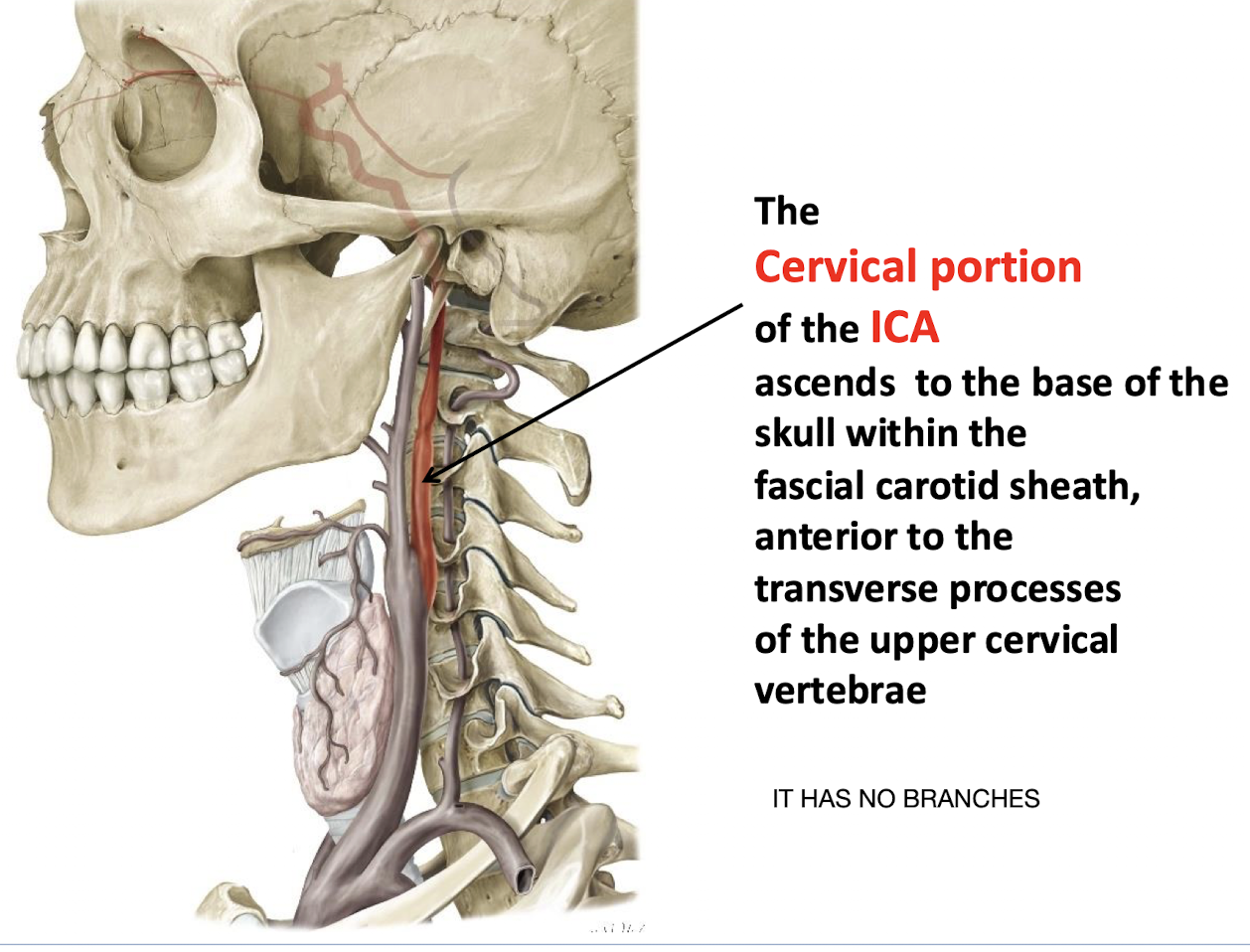
Where does and what portion of the ICA enters the cranial cavity; and where does the cavernous portion course?
The petrous portion enters the cranial cavity through the CAROTID CANAL; and then the cavernous portion courses through the cavernous sinus just lateral to the sella turcica
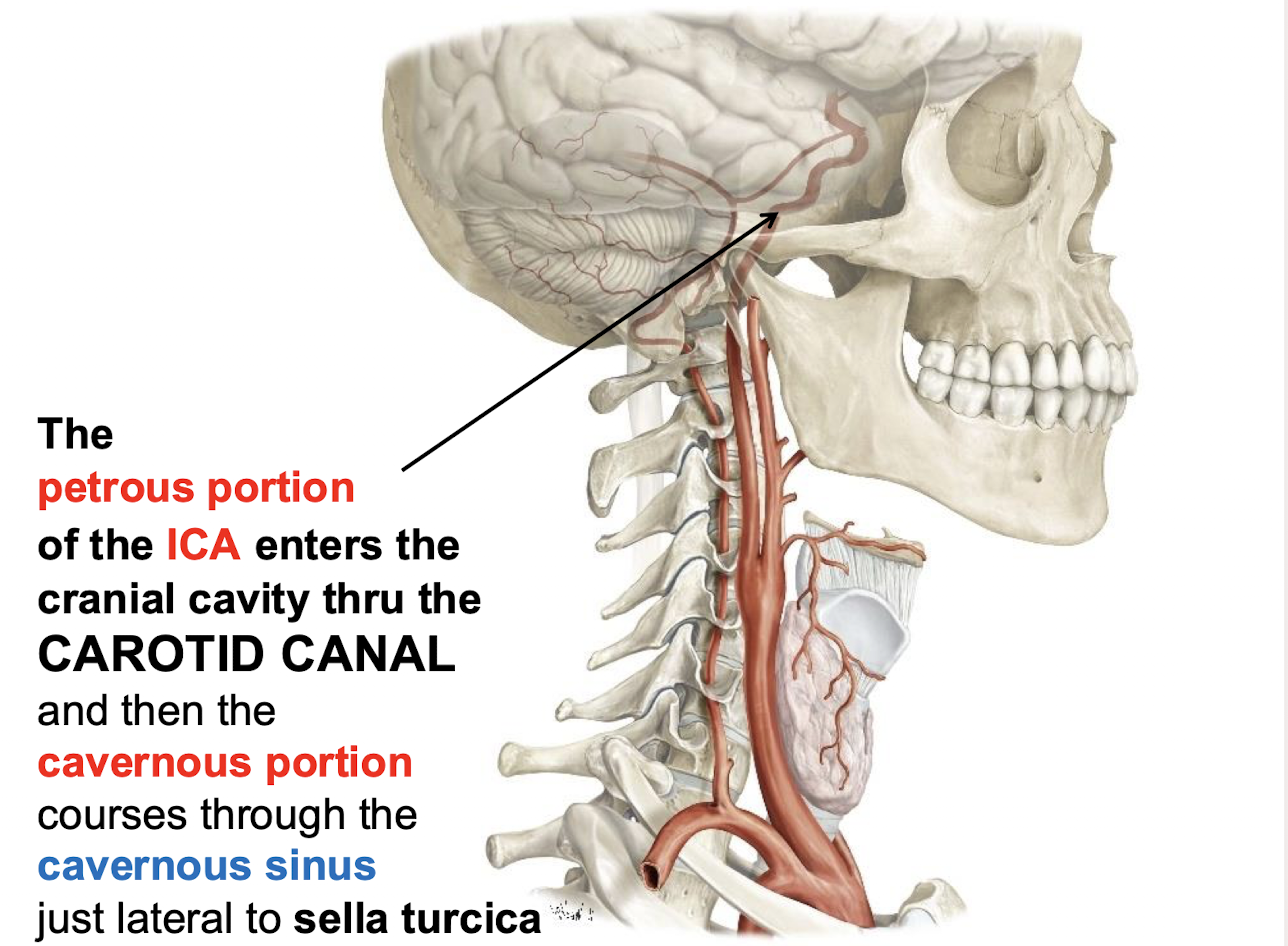
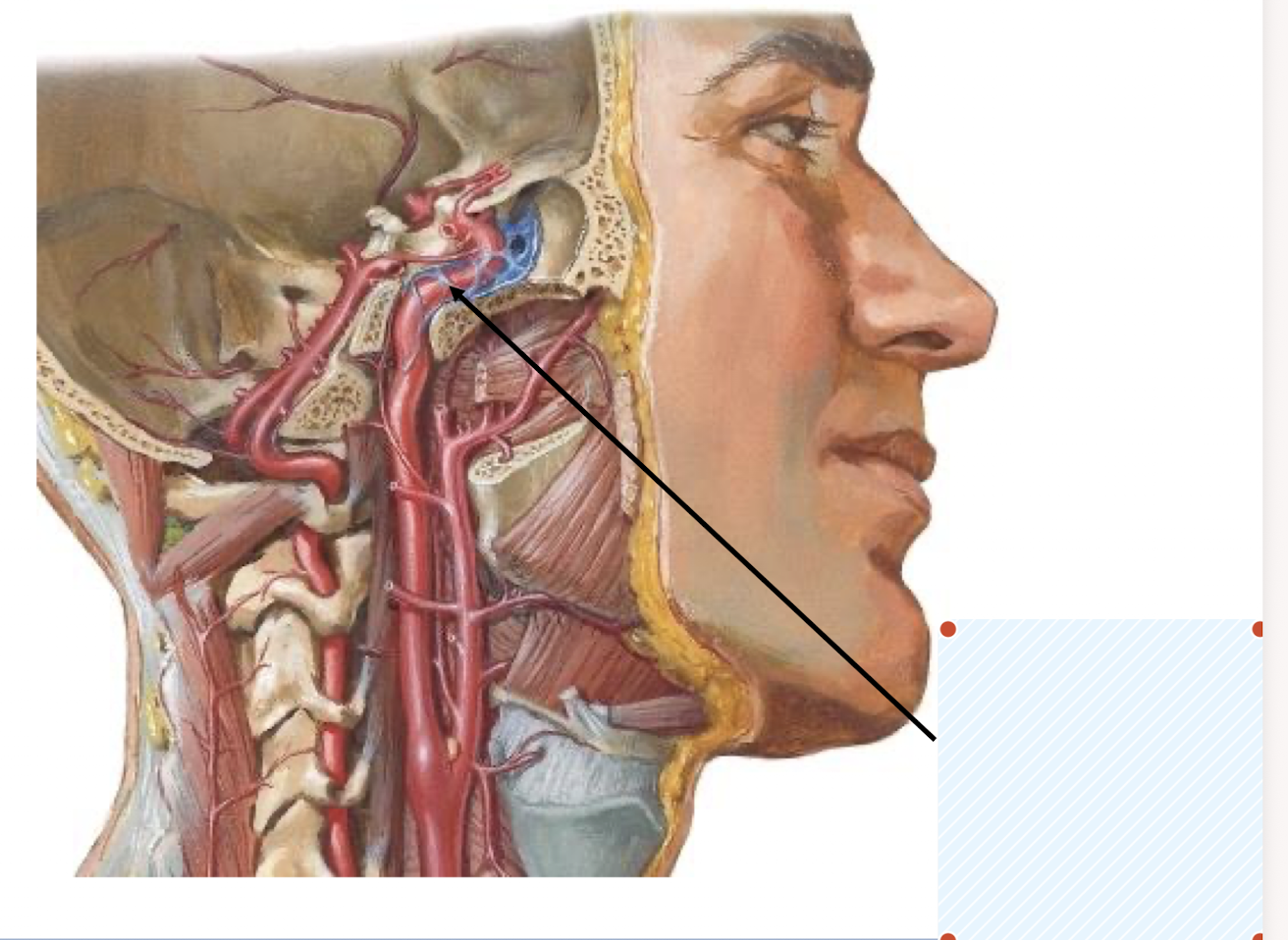
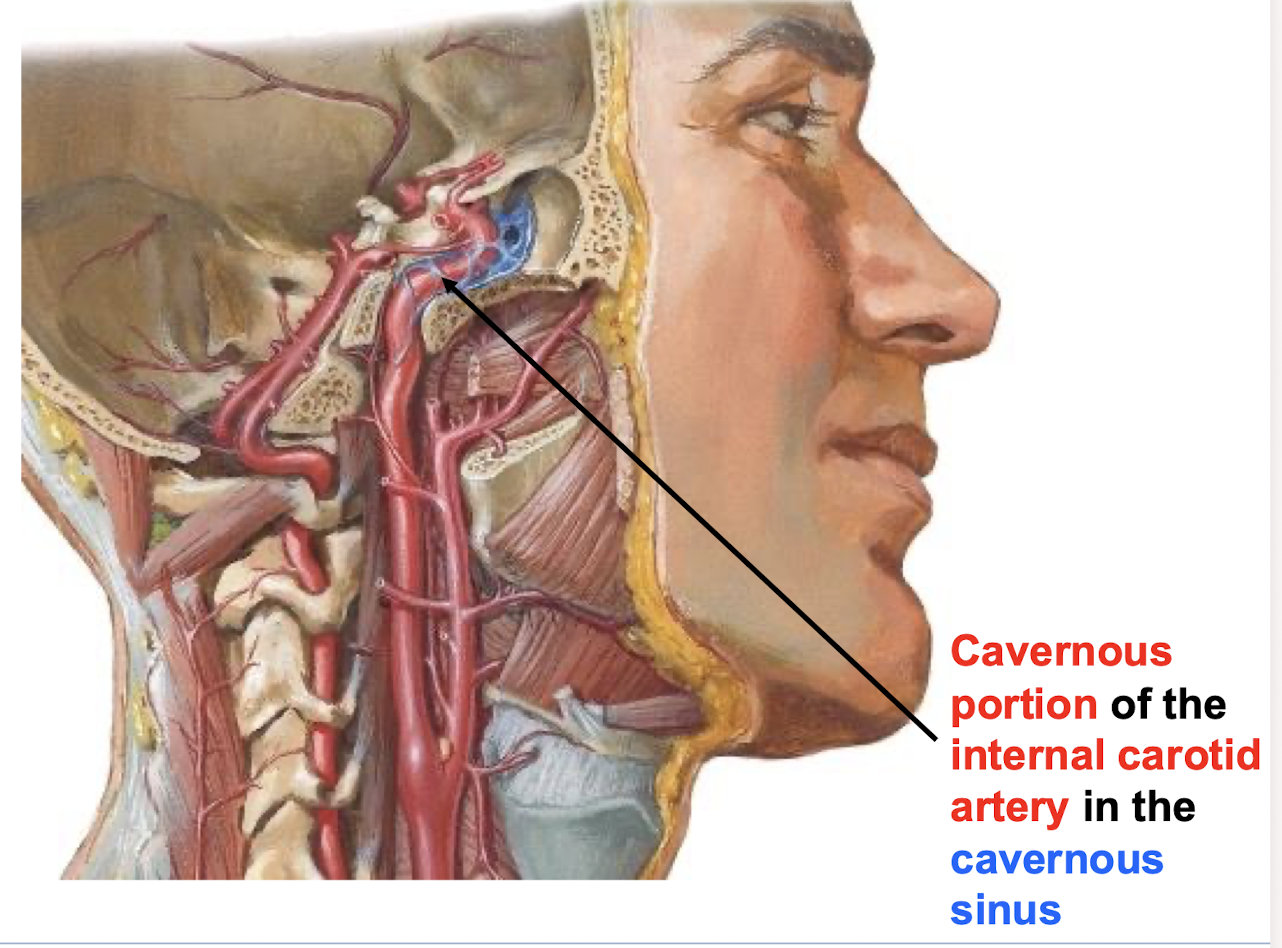
What symptoms might an aneurysm of the cavernous portion of the ICA produce? What nerves is this related to?
Due to the proximity of the cavernous portion of the ICA to CN III; IV; and VI. An aneurysm may produce OPHTHALMOPLEGIA (paralysis or weakness of eye muscles)

What problems related to the cavernous sinus may affect the ICA?
Septic infection and thrombosis of the cavernous sinus may reduce blood flow through the ICA.
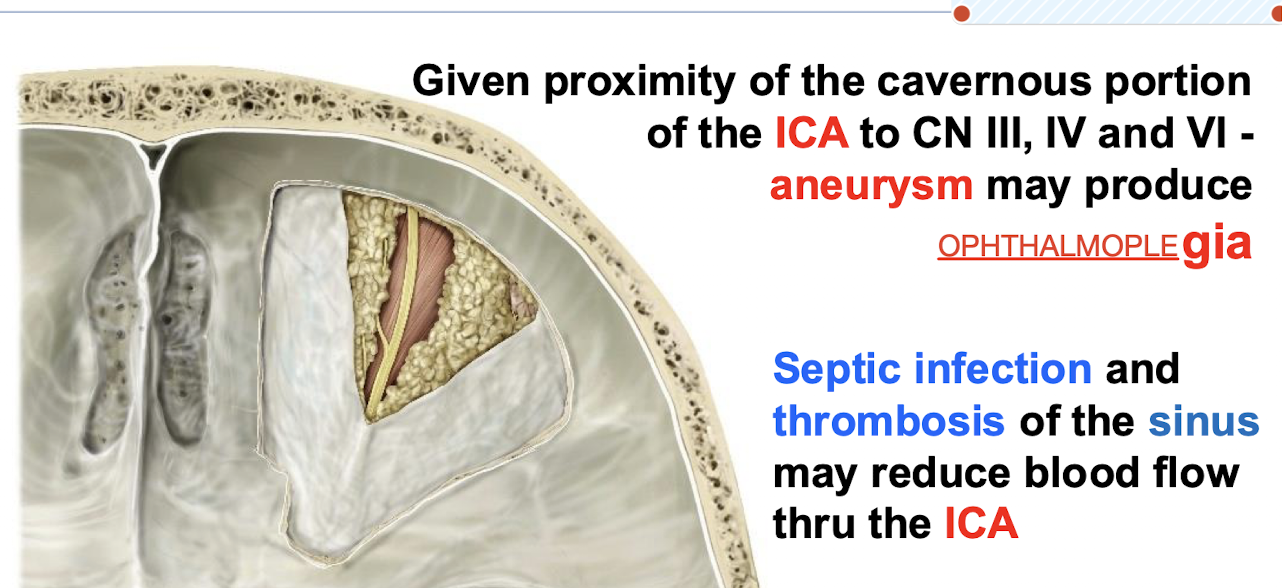
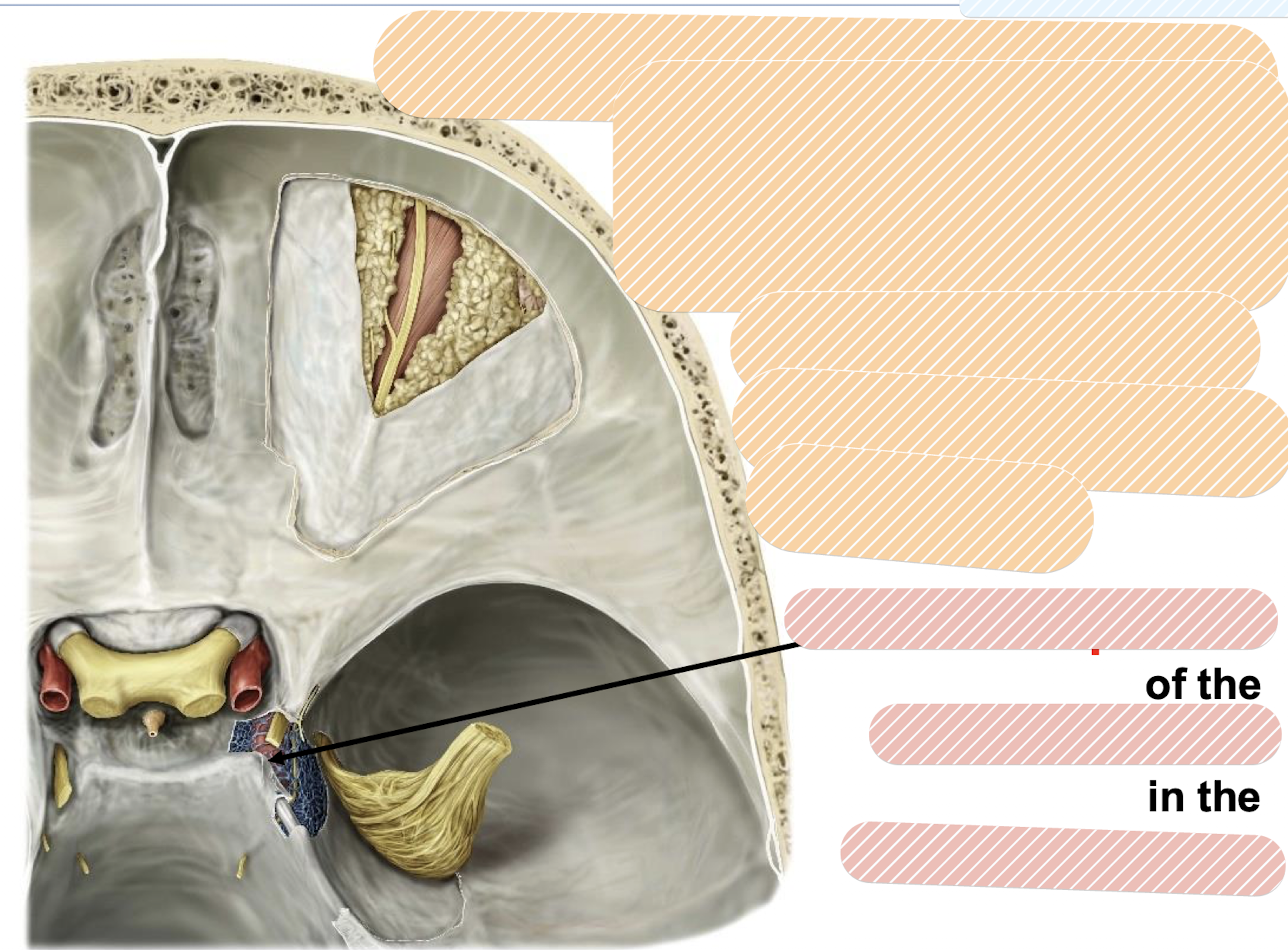
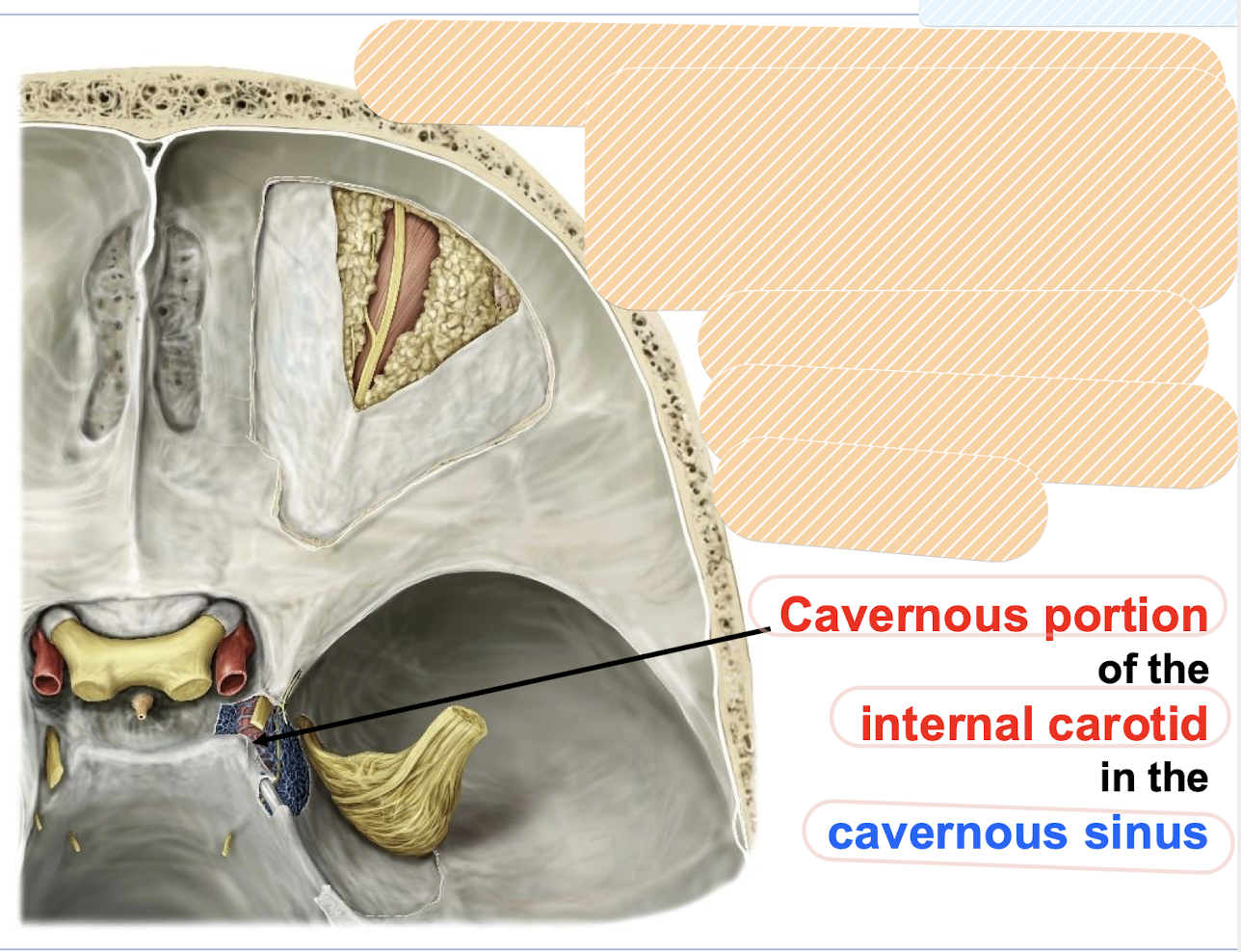
What is the CEREBRAL (SUPRACLINOID) PORTION of the ICA?
The part that arises as the vessel pierces the dural roof of the cavernous sinus.
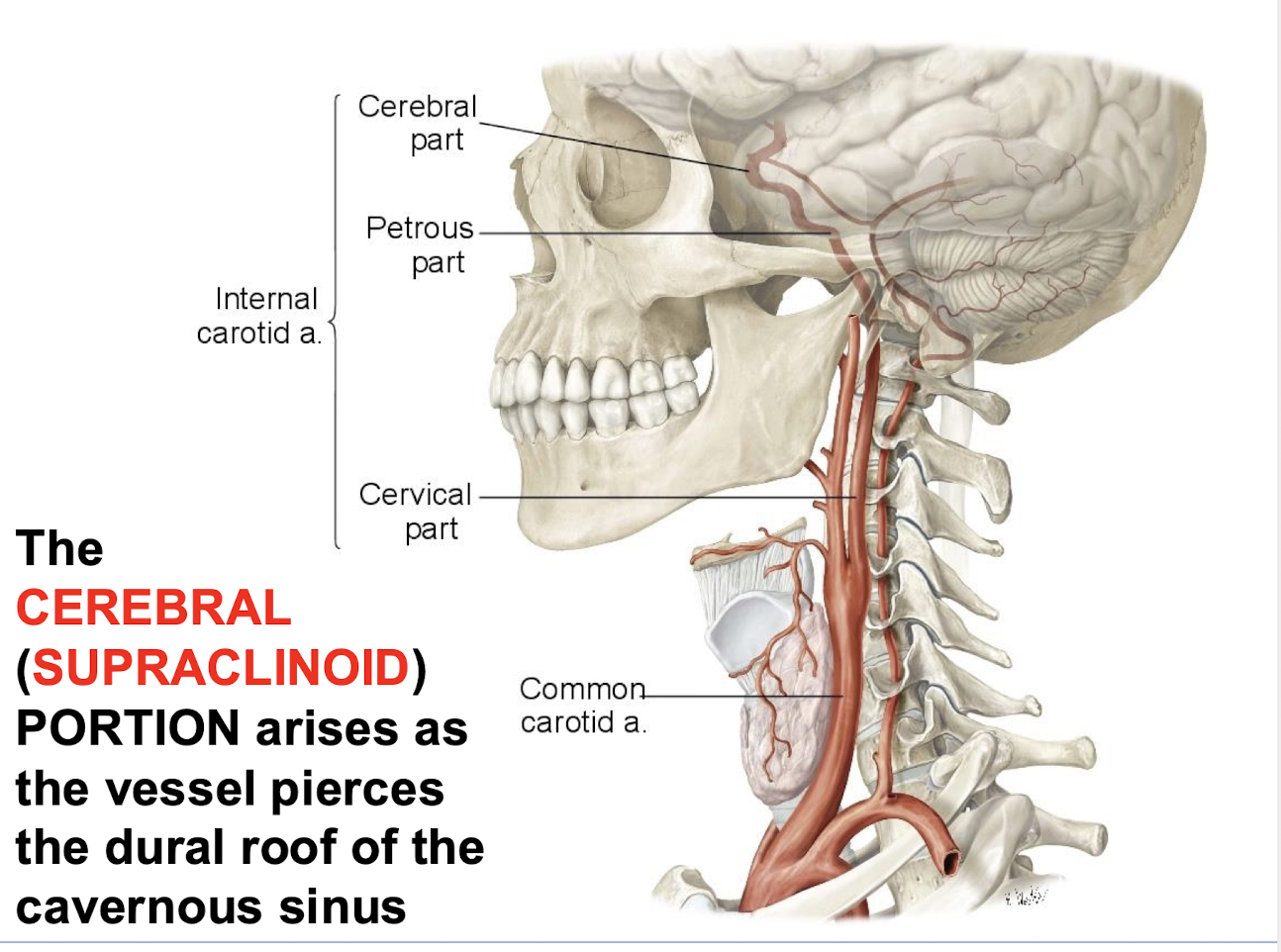
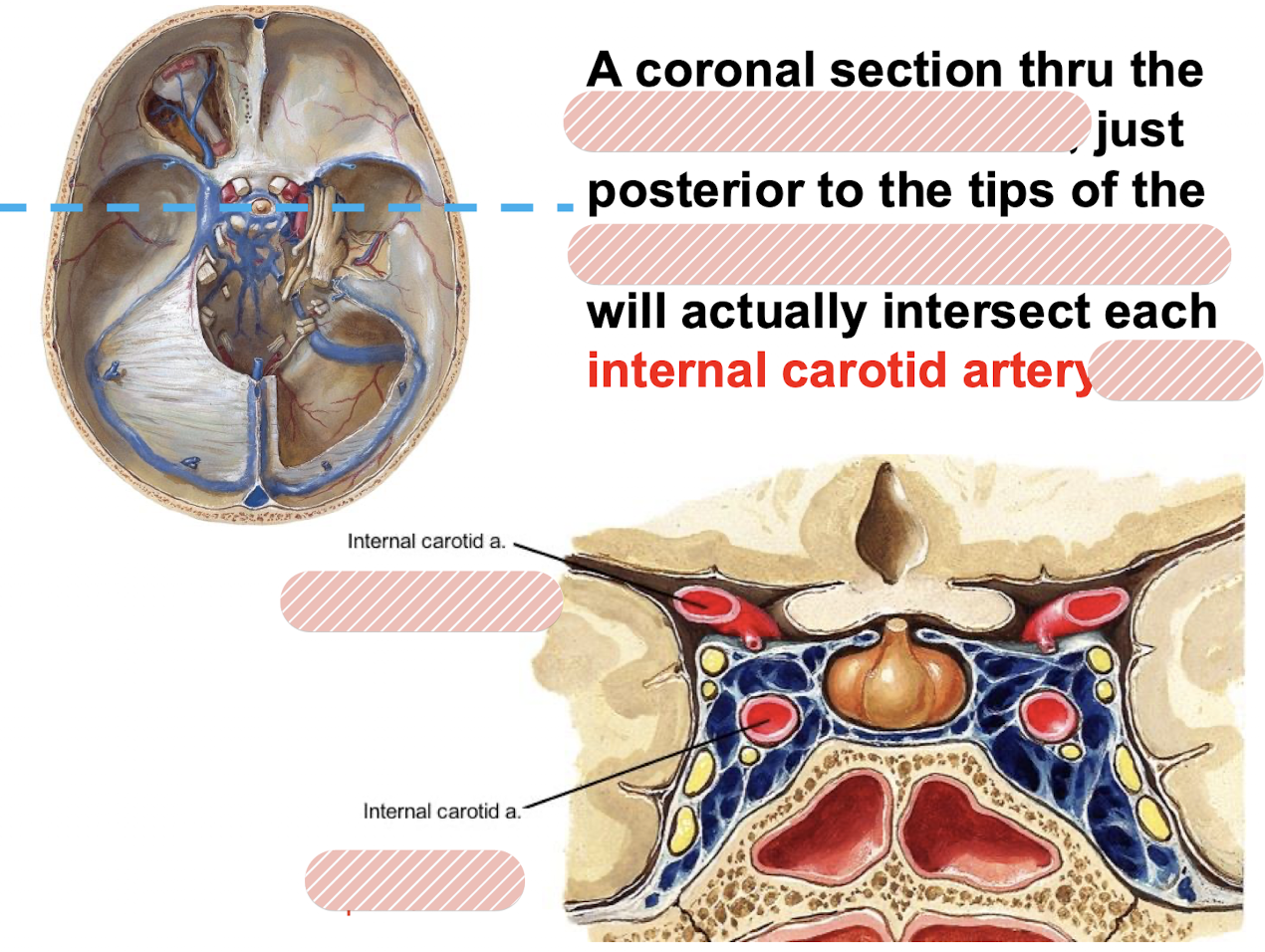
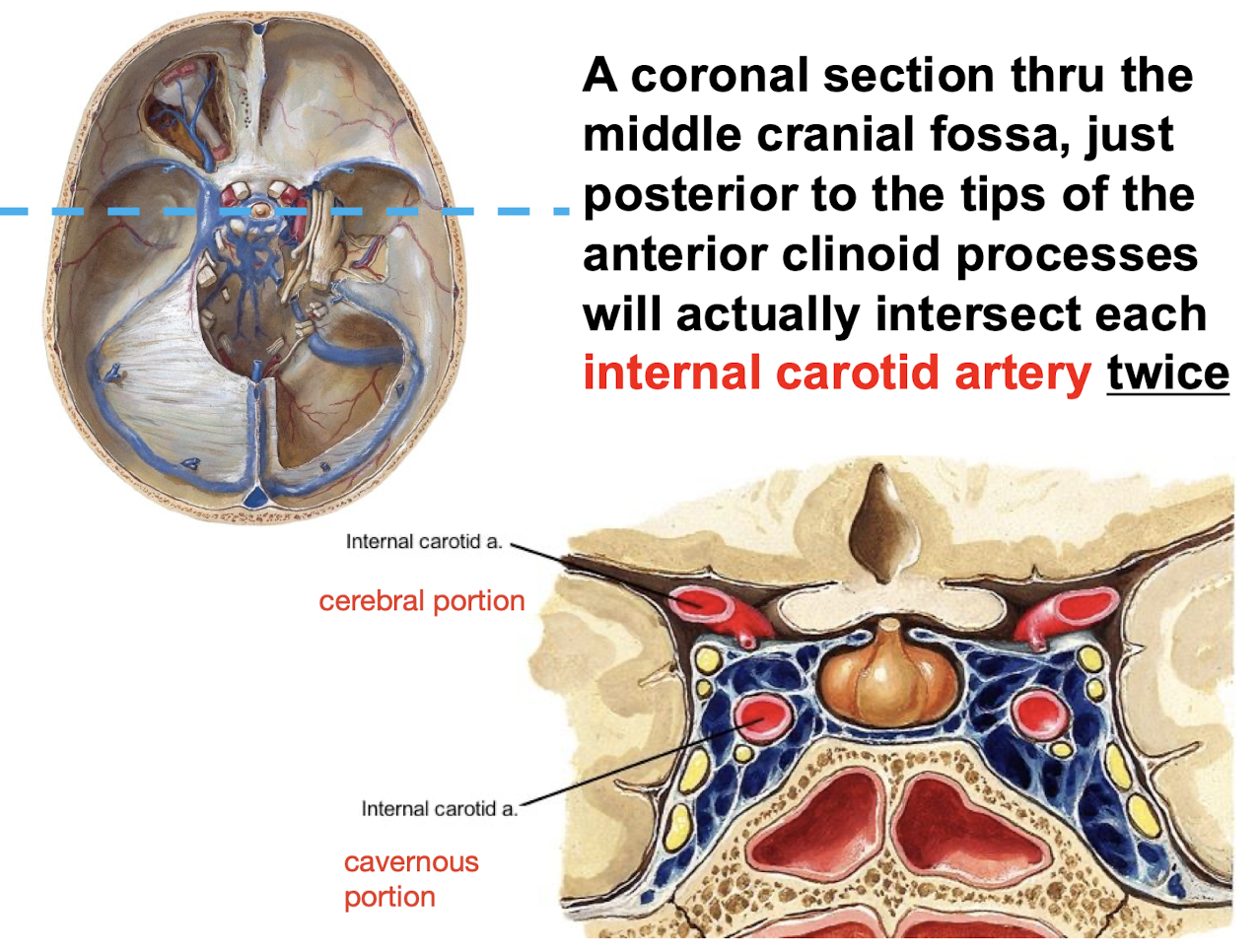
What artery originates from the cerebral portion of the Internal Carotid Artery and supplies the orbital contents?
The ophtalmic artery courses through the optic canal with CN II; and supplies blood to all of the orbital contents
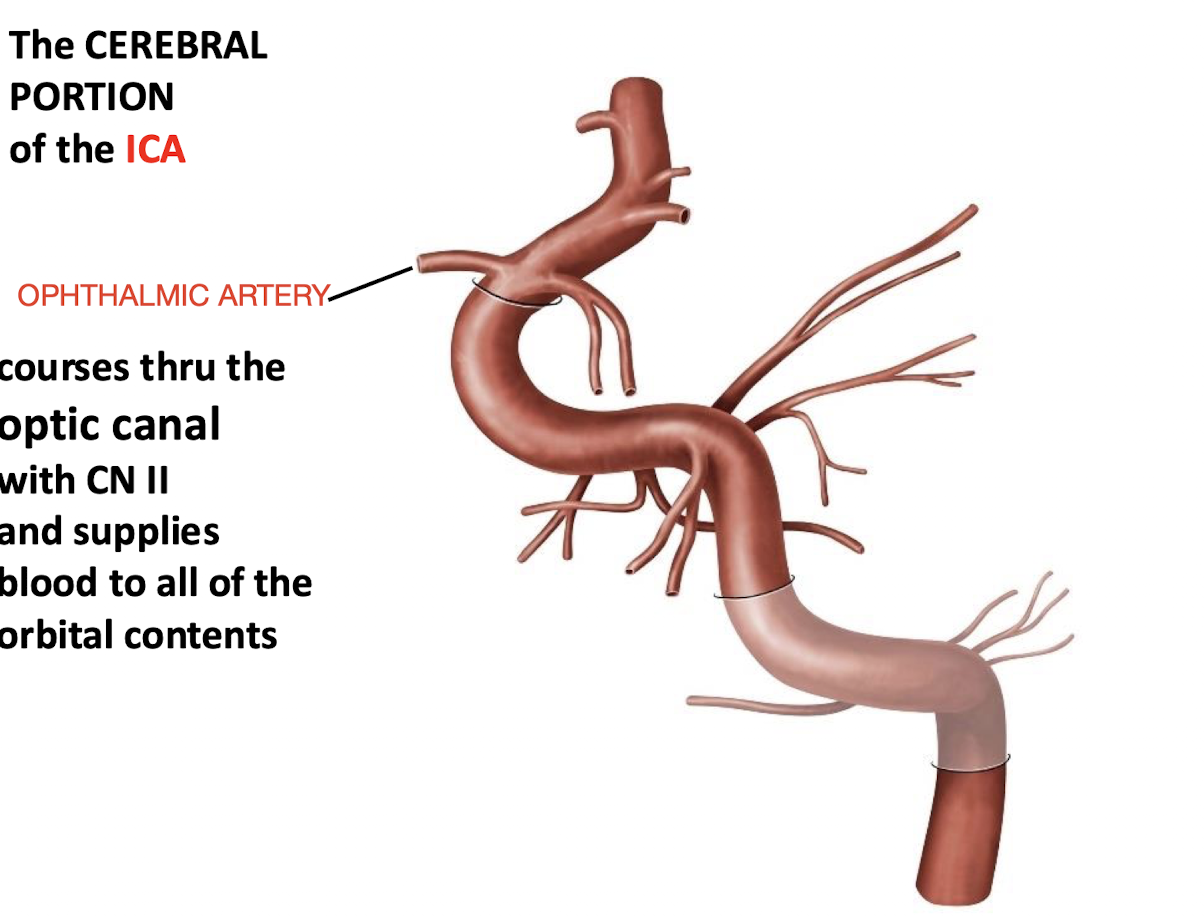
What are the key branches of the OPHTHALMIC artery
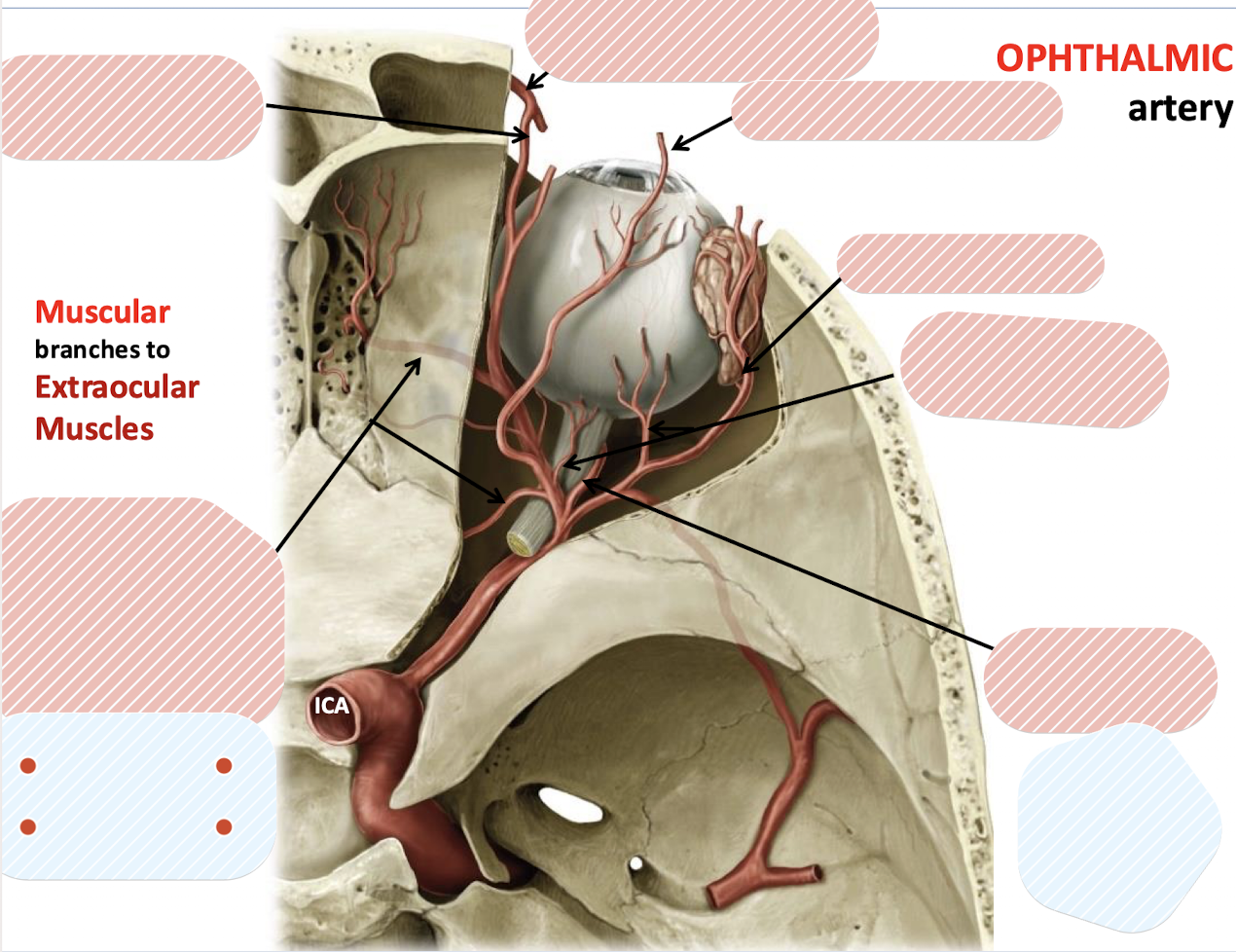
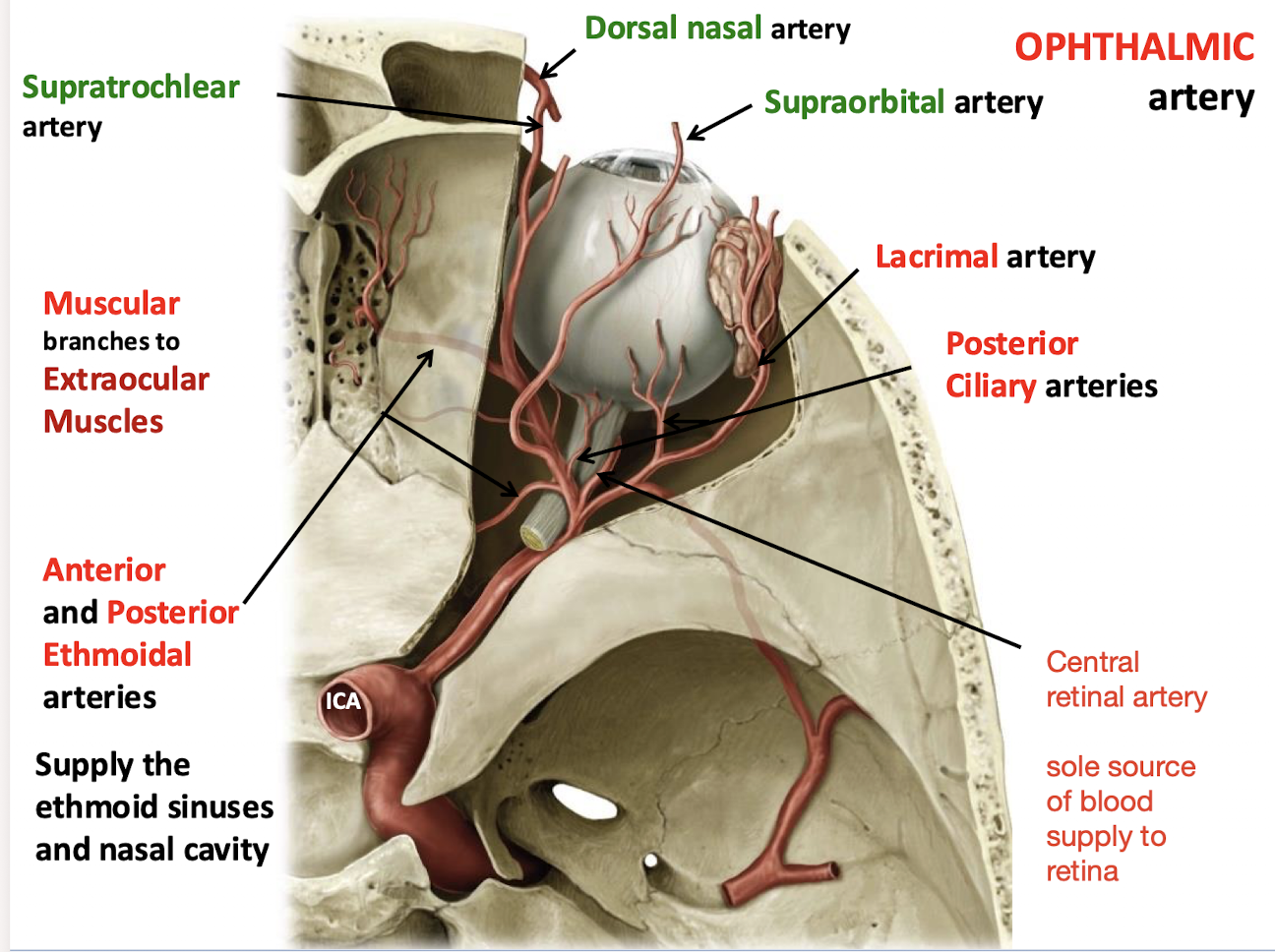
Anterior and Posterior Ethmoidal arteries; Supratrochlear artery; Supraorbital artery; Lacrimal artery; Posterior Ciliary arteries; Muscular branches to Extraocular Muscles; Central retinal artery
What is the sole source of blood supply to the retina; and what type of artery is it an example of?
Central retinal artery; an example of an end artery
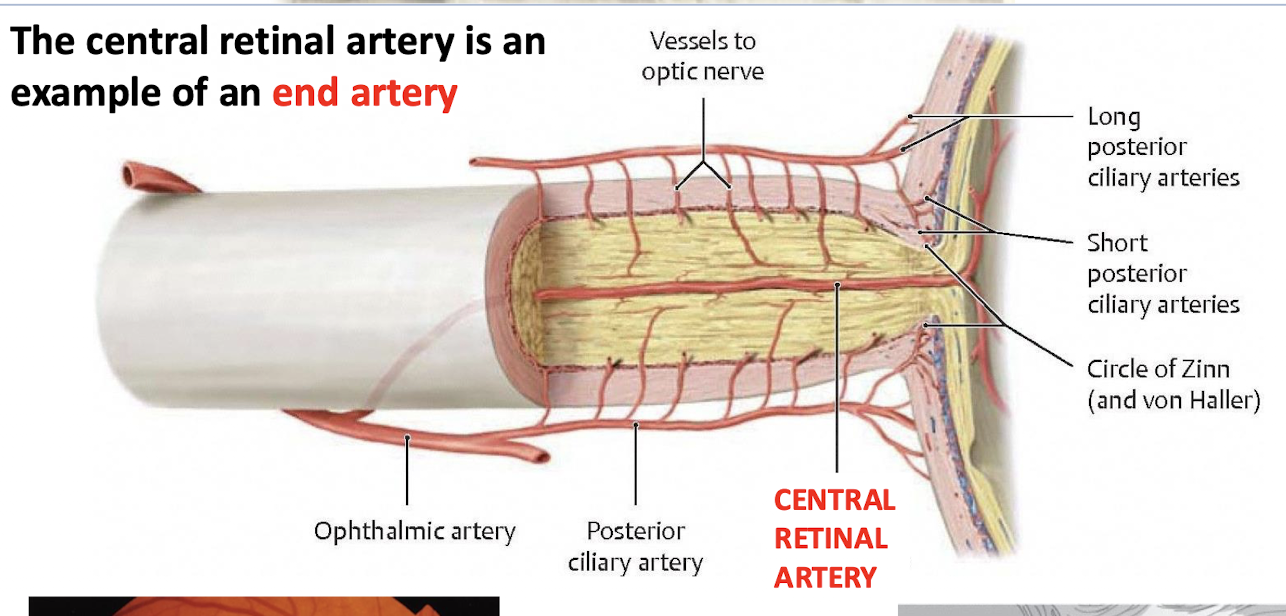
How many branches does the central retinal artery have and what do they course through?
Four branches through the OPTIC DISK
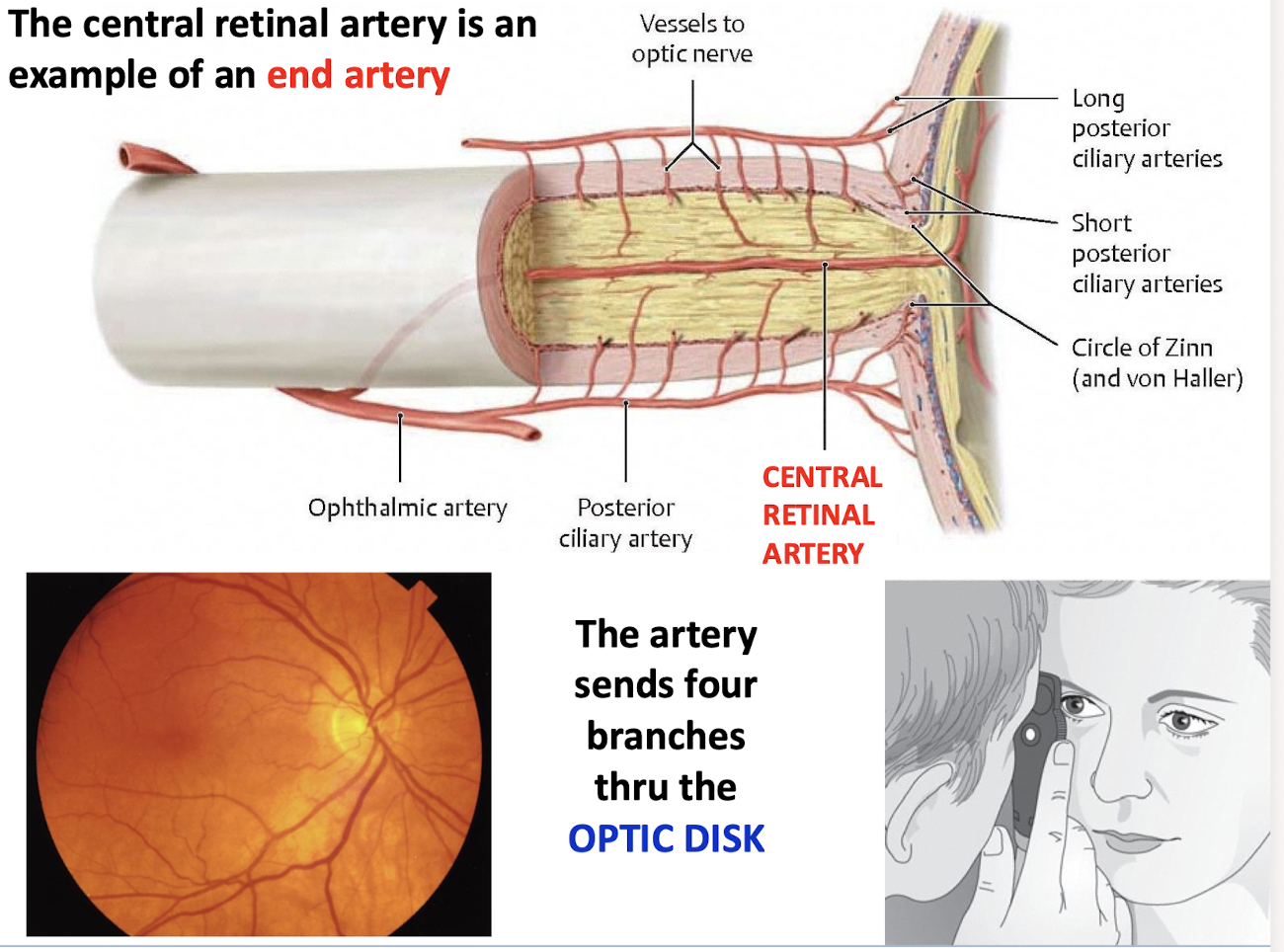
Which three branches of the OPHTHALMIC ARTERY supply the skin of the forehead; root; and bridge of the nose
Supratrochlear artery; Supraorbital artery; Dorsal nasal artery
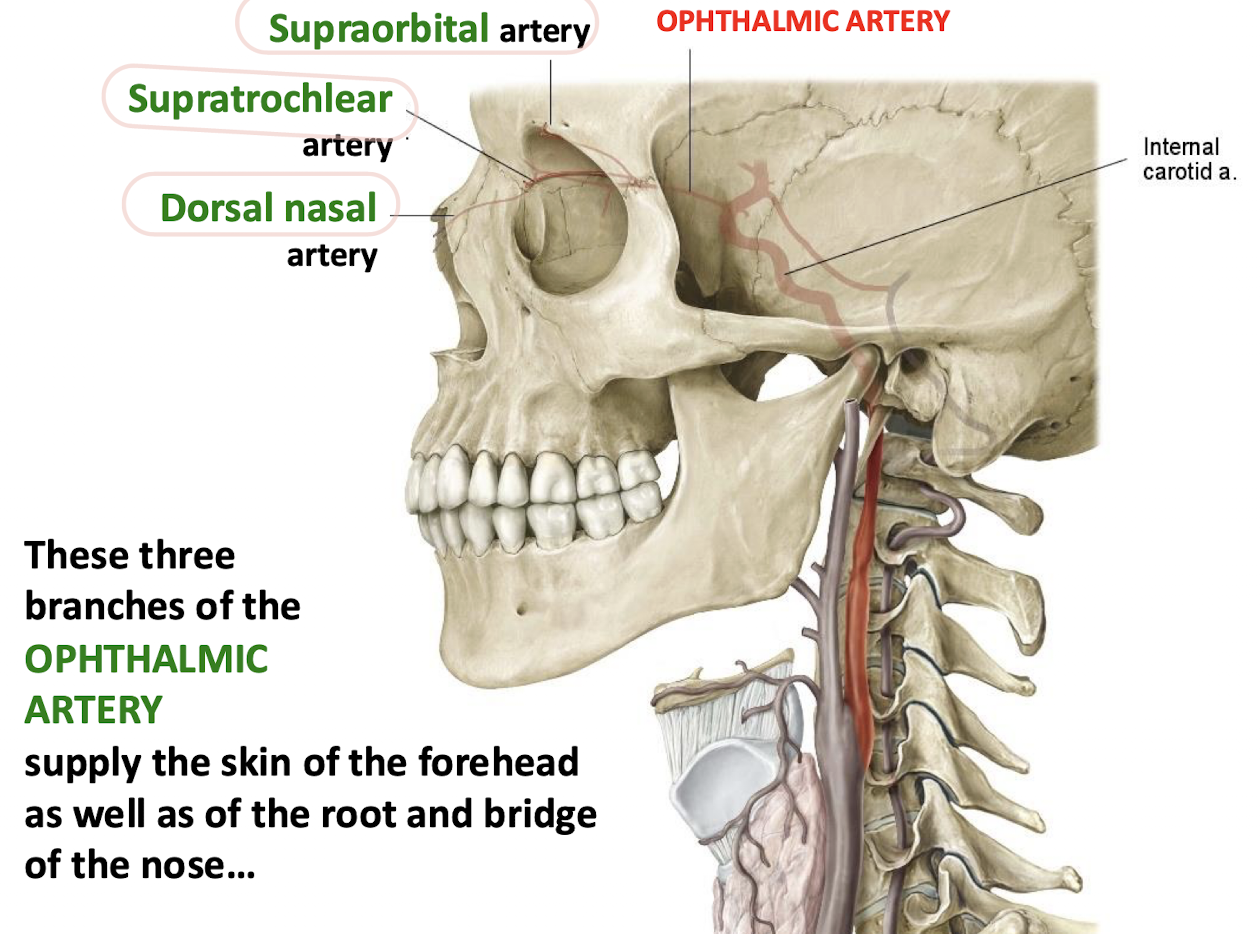
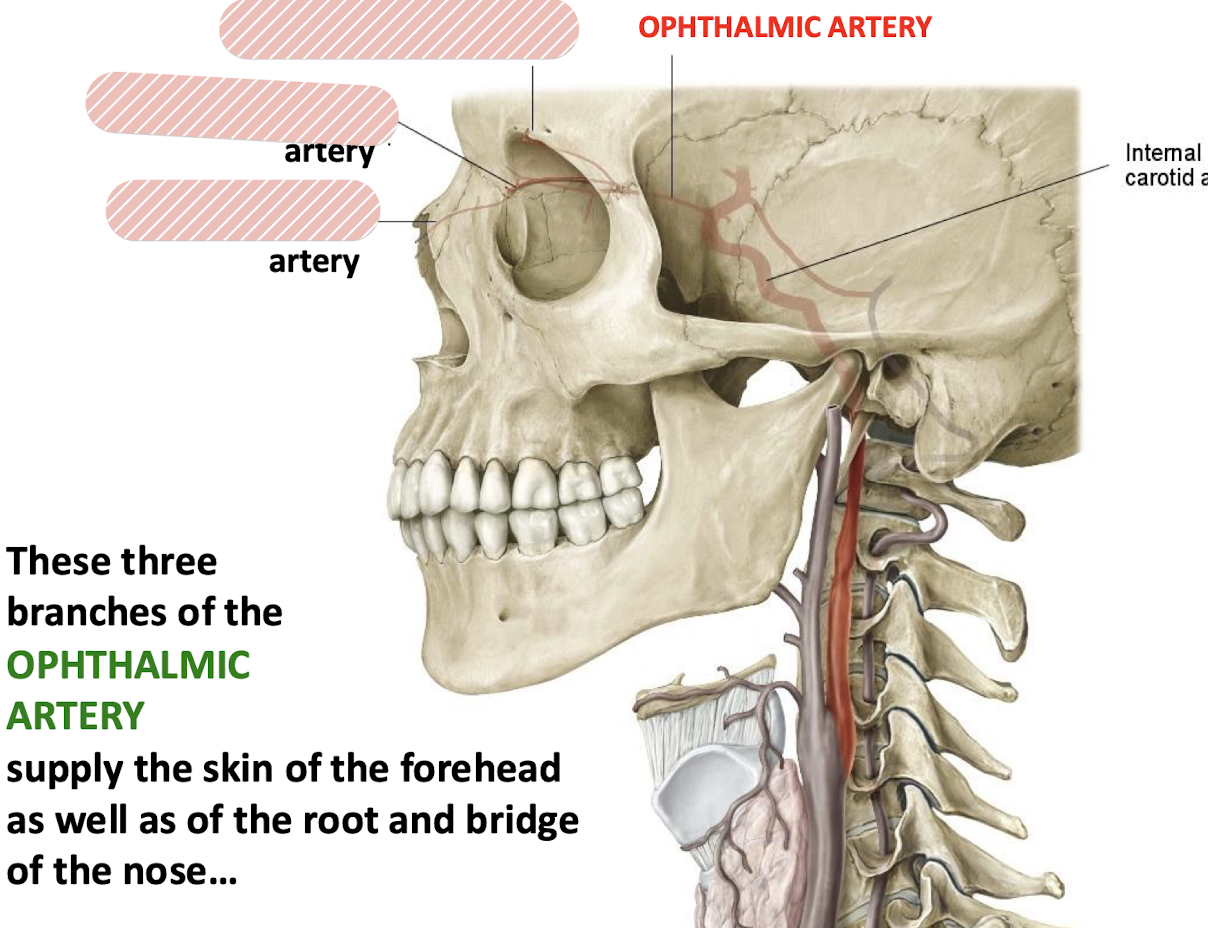

What do the supraorbital, supratrochlear and dorsal nasal branches of the opthalmic artery anastamose with?
Branches of the external carotid supplying the face and scalp
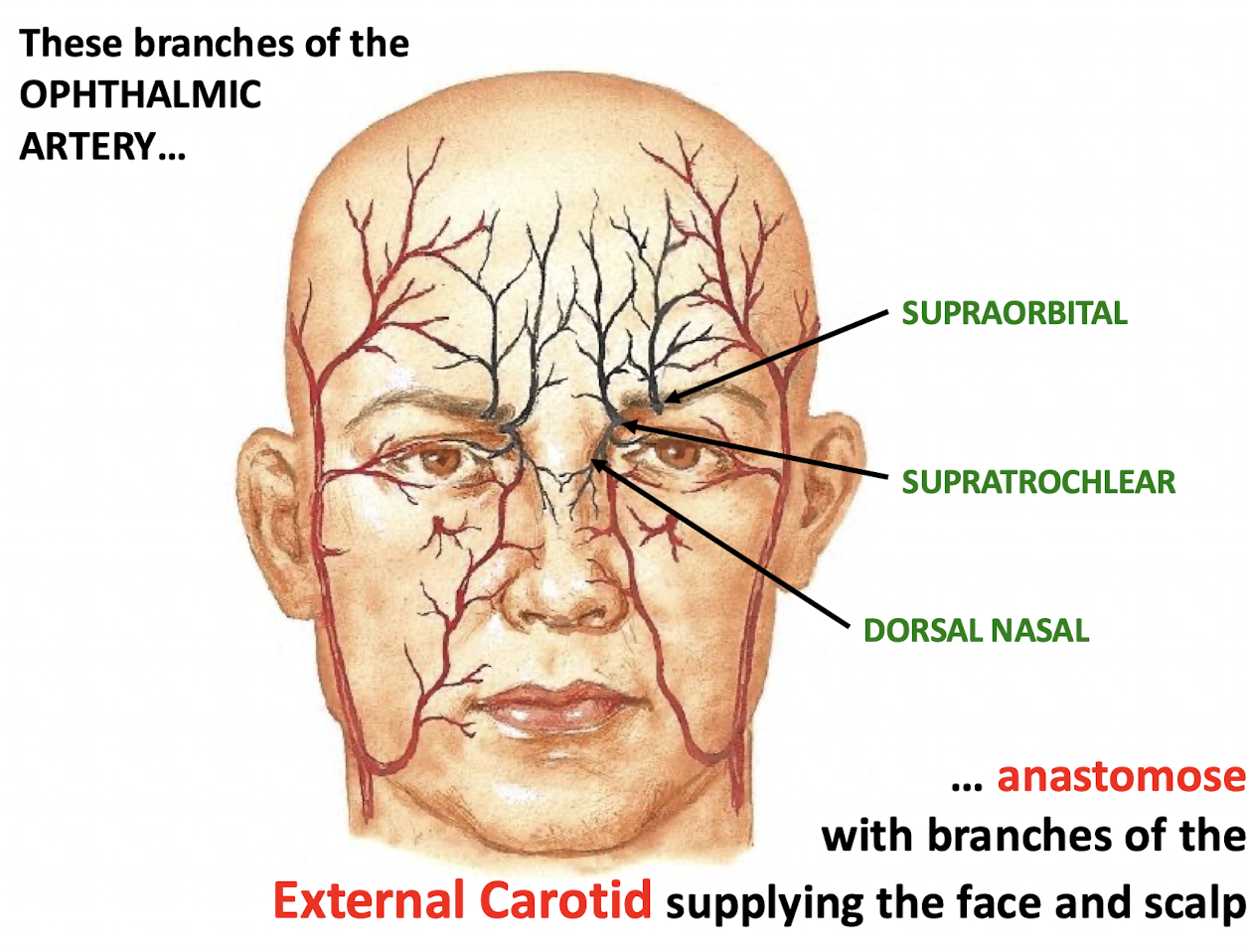
With occlusion of the ICA at or above its origin; how does collateral flow occur into the internal carotid circulation in the cranial cavity?
Collateral flow occurs from external carotid branches INTO the internal carotid circulation via the OPHTHALMIC artery
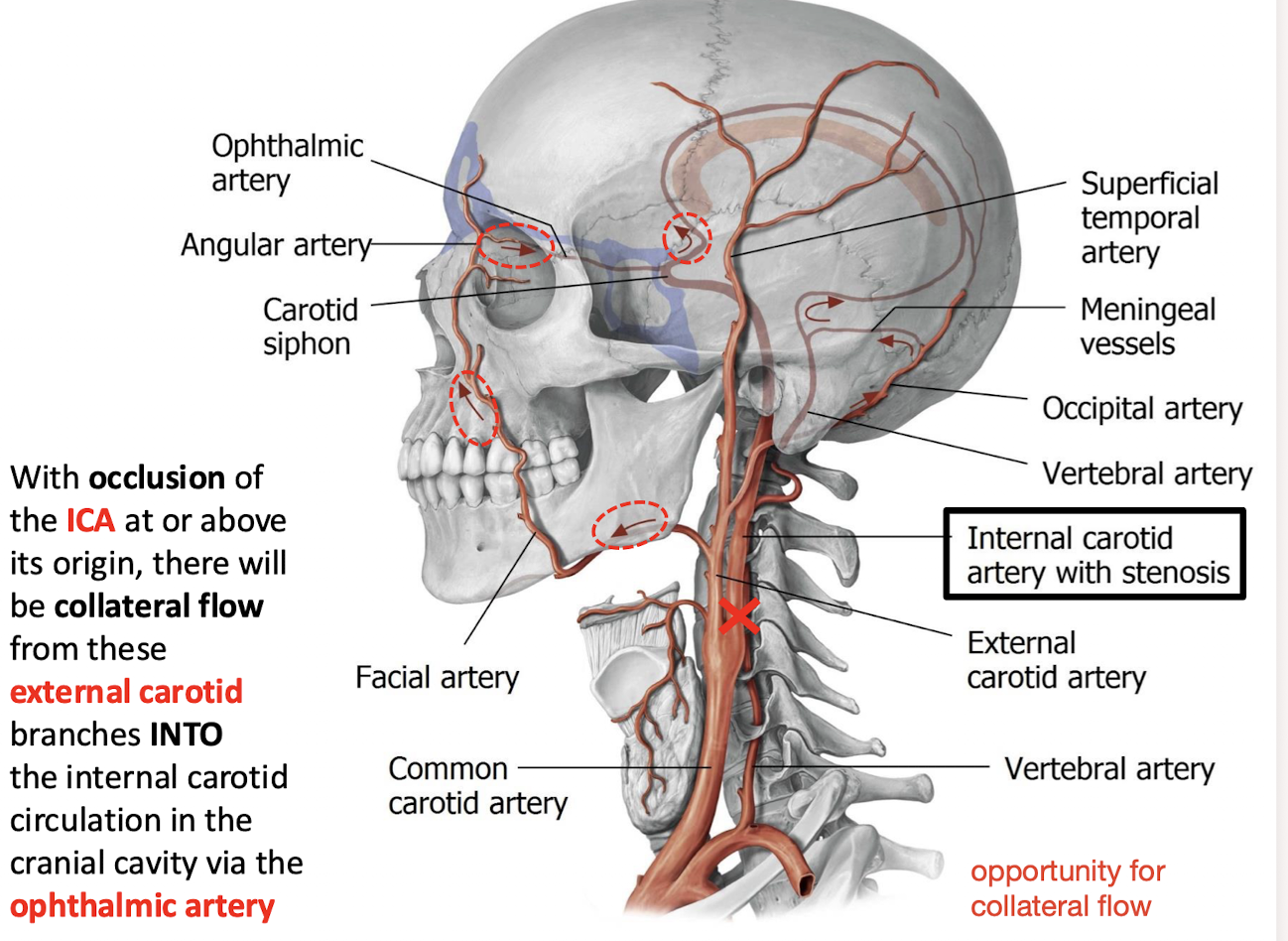
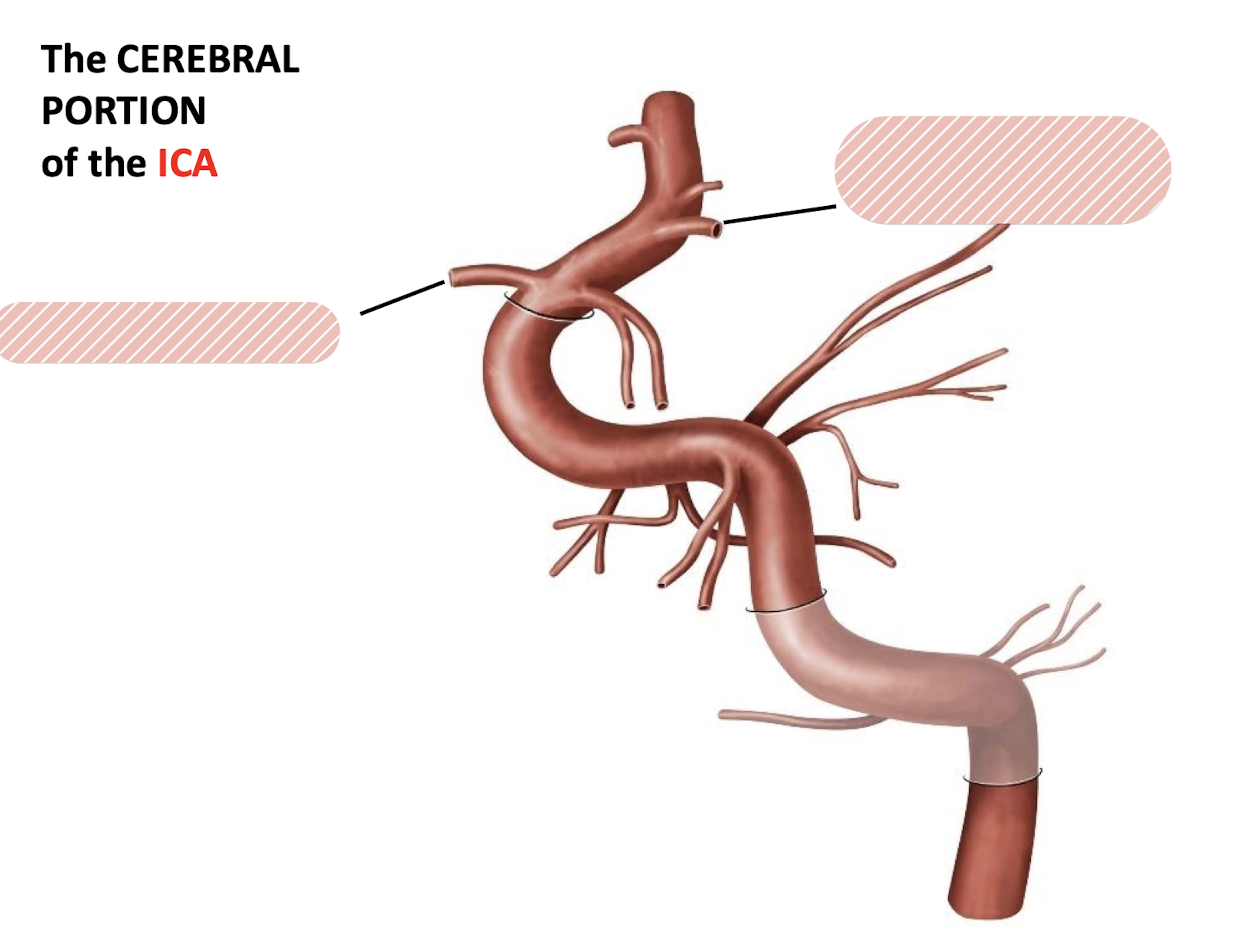
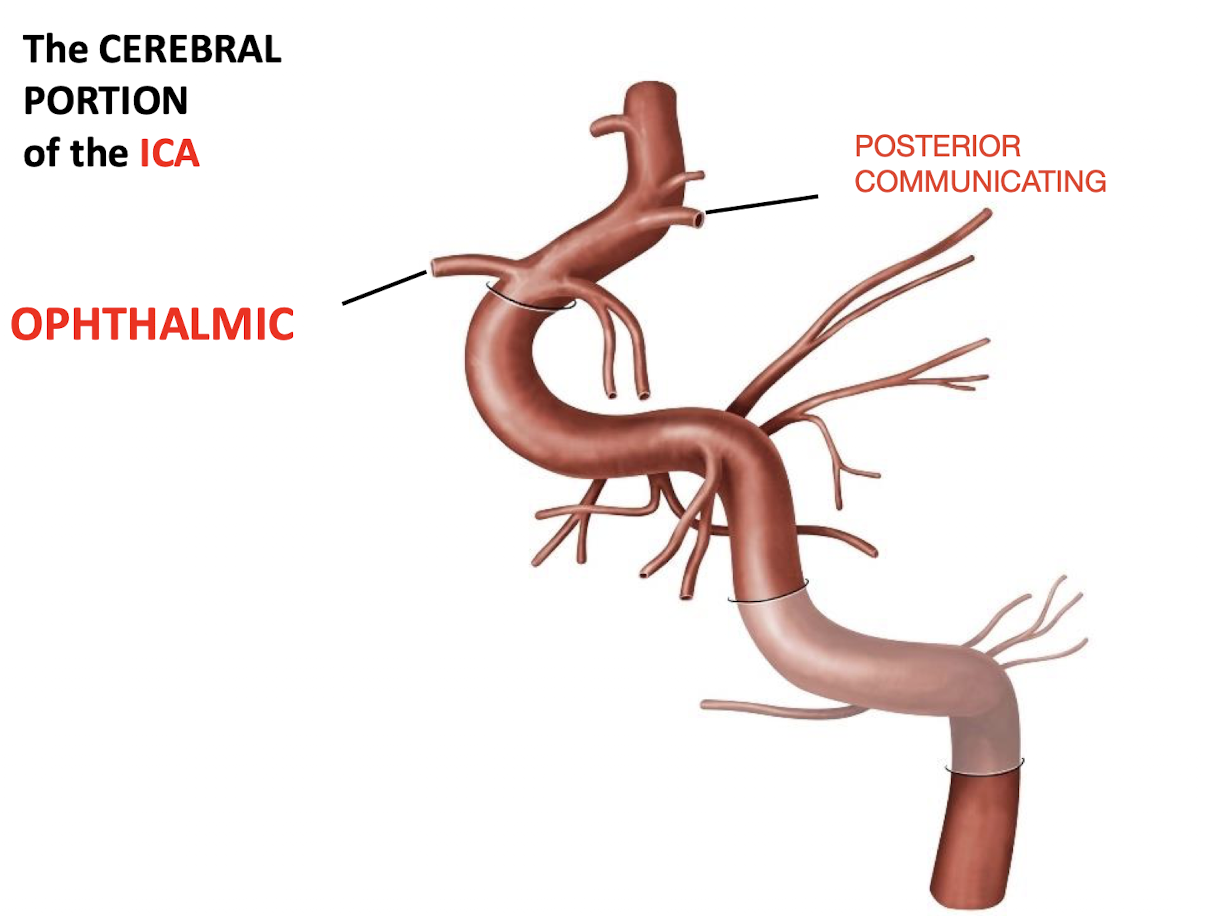
What important role does the POSTERIOR COMMUNICATING ARTERY (PCOM) play in circulation?
It plays an important role in formation of the “Circle of Willis;” communicating between the Internal Carotid and Vertebro-basilar circulations.
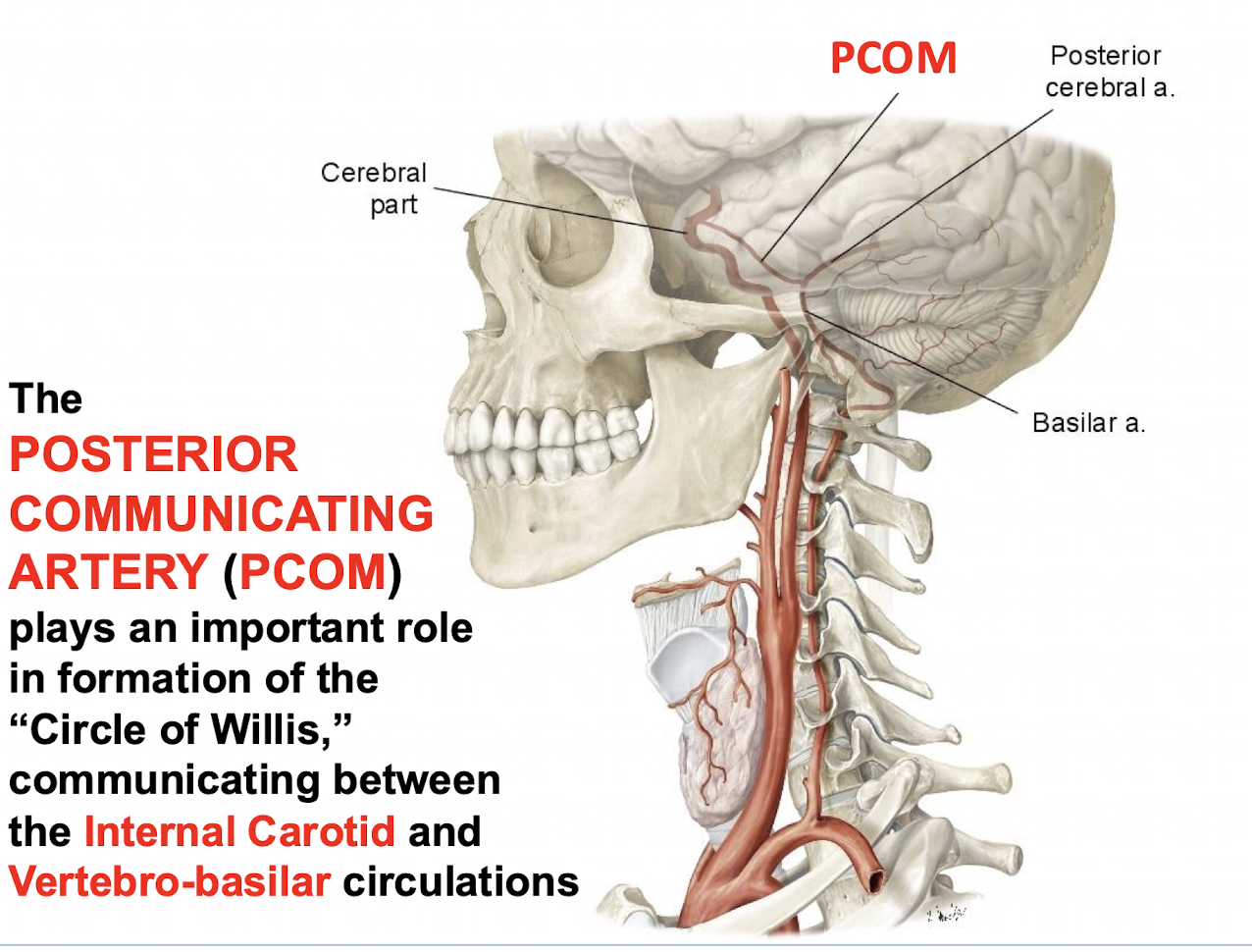
What structure is the critical site of anastomosis between the VERTEBRO-BASILAR and INTERNAL CAROTID circulations?
The inaccurately named “CIRCLE OF WILLIS”
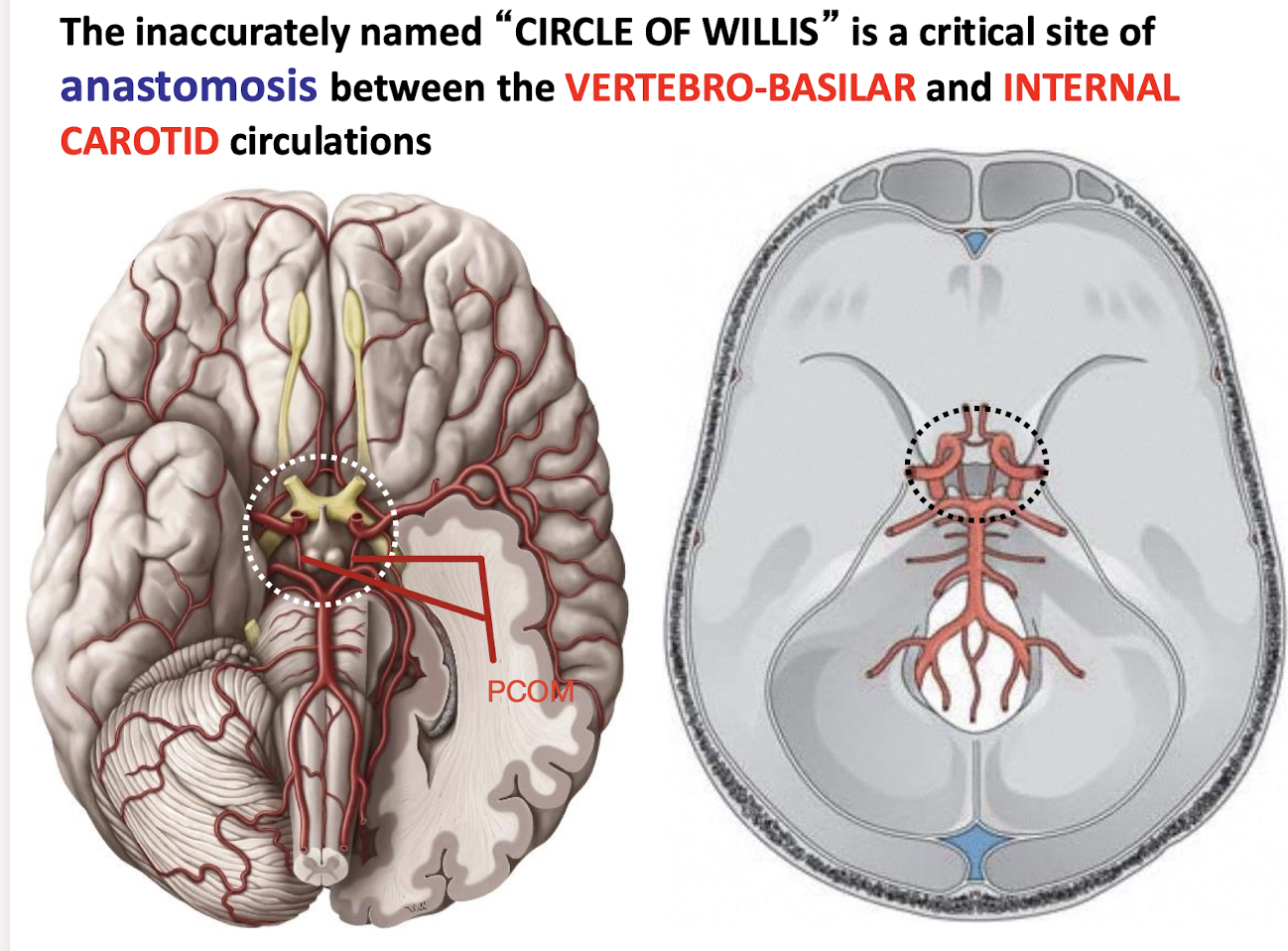
What two main arteries arise from the terminal bifurcation of the CEREBRAL PORTION of the ICA
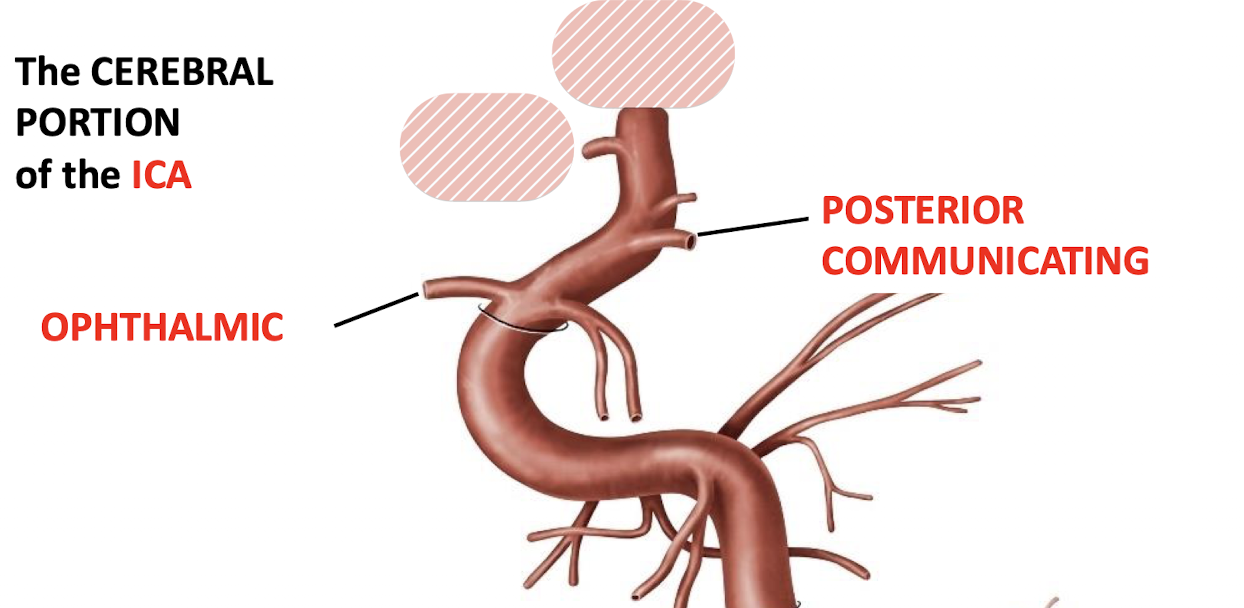
The ANTERIOR CEREBRAL ARTERY (ACA) and MIDDLE CEREBRAL ARTERY (MCA)
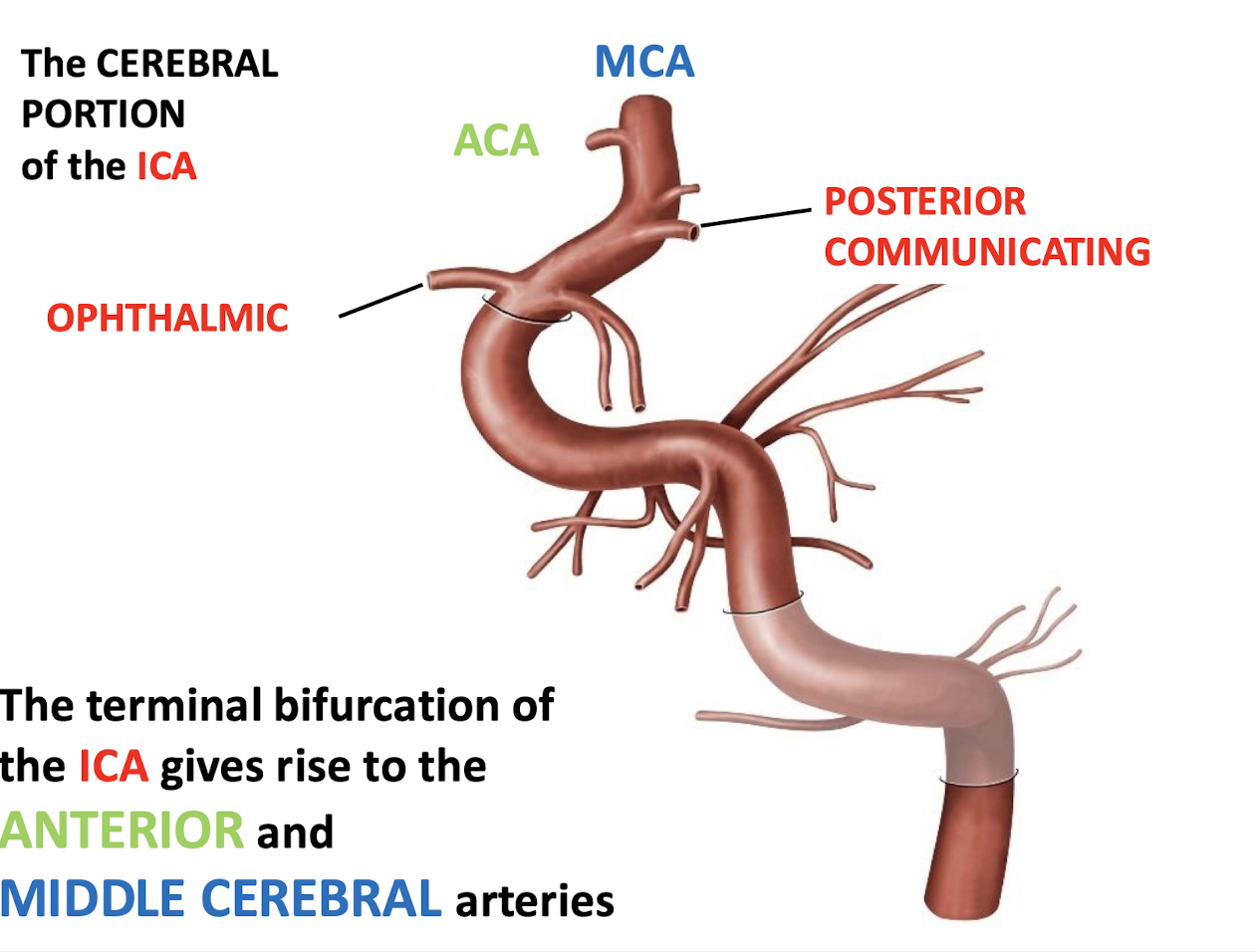
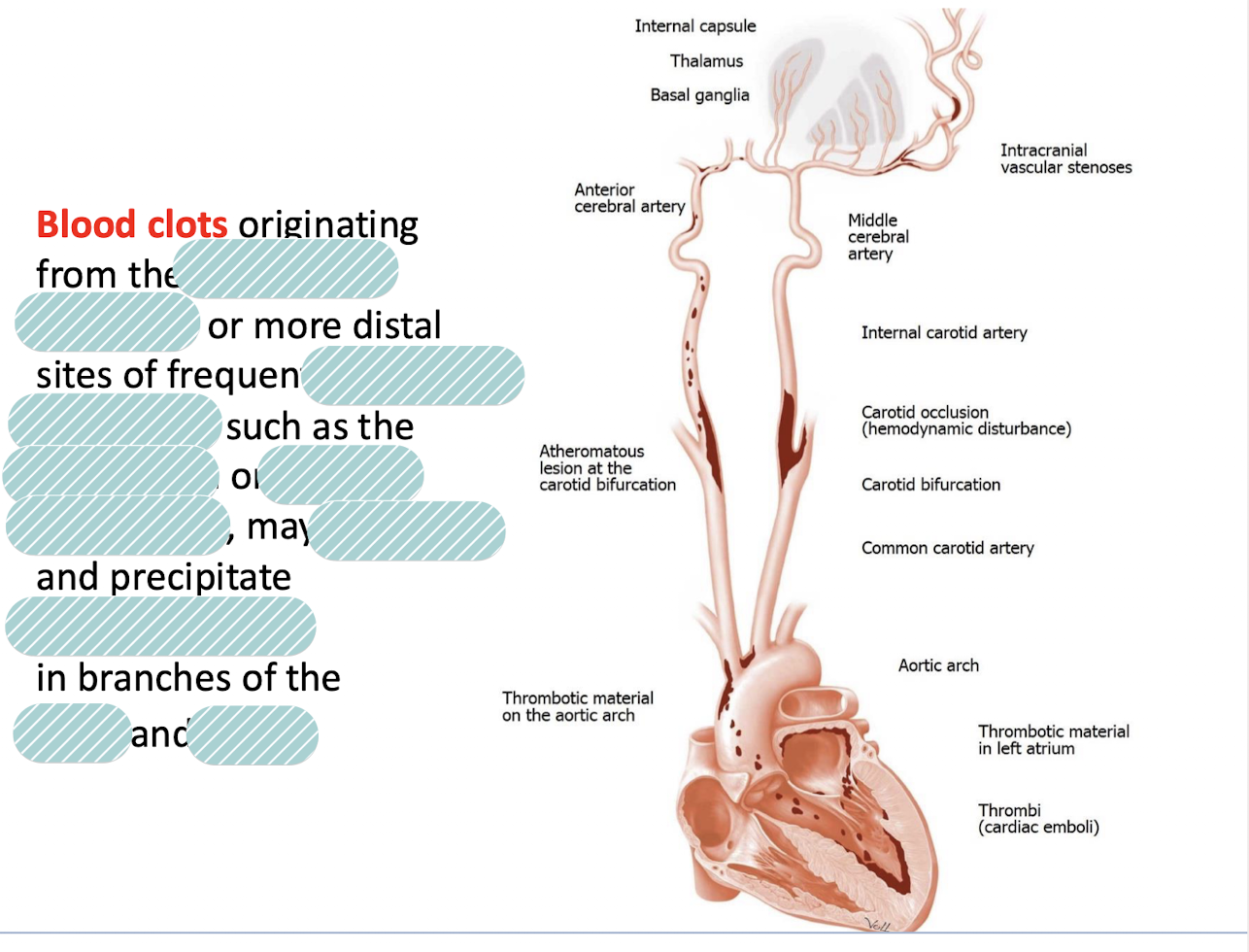
The ACA and MCA
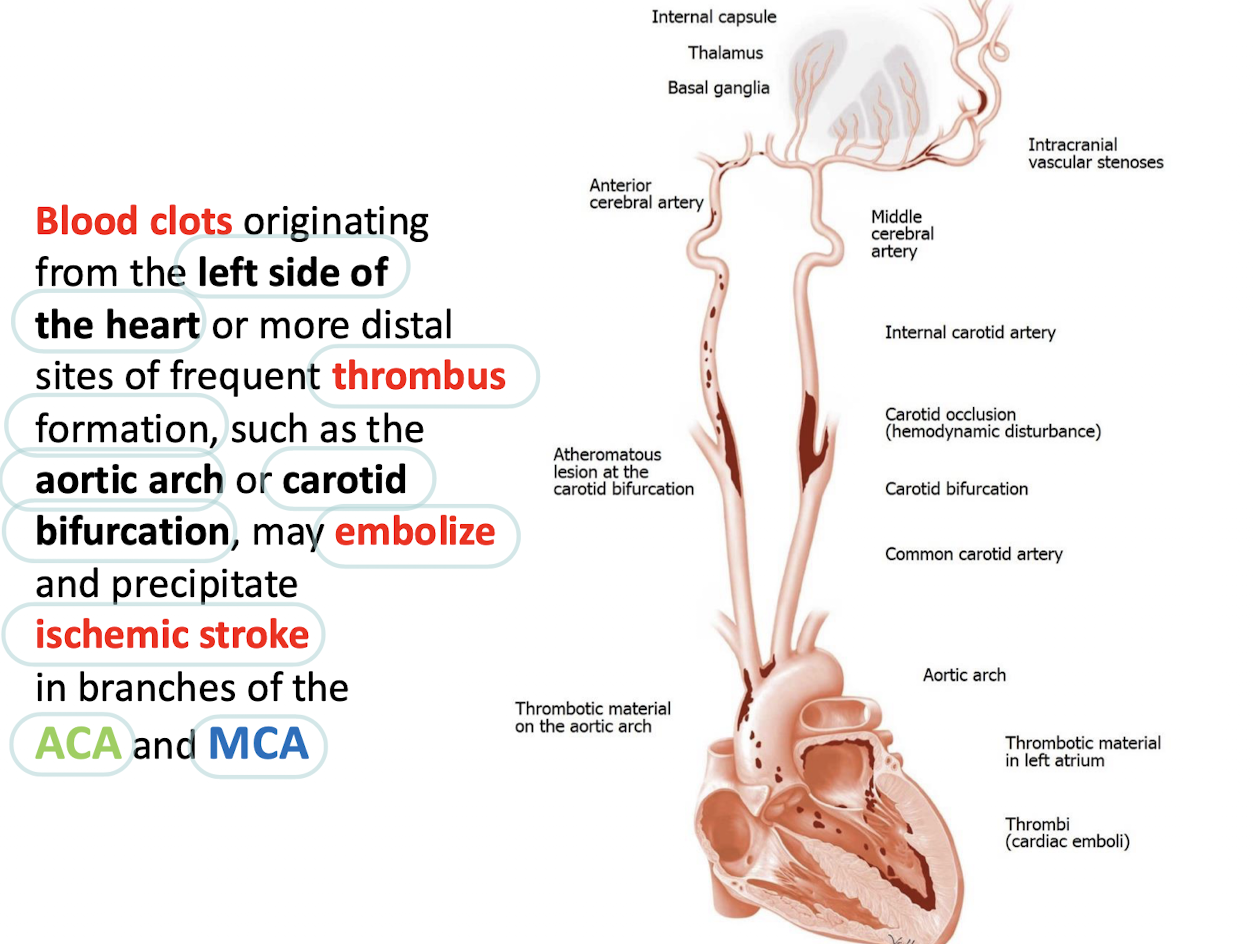
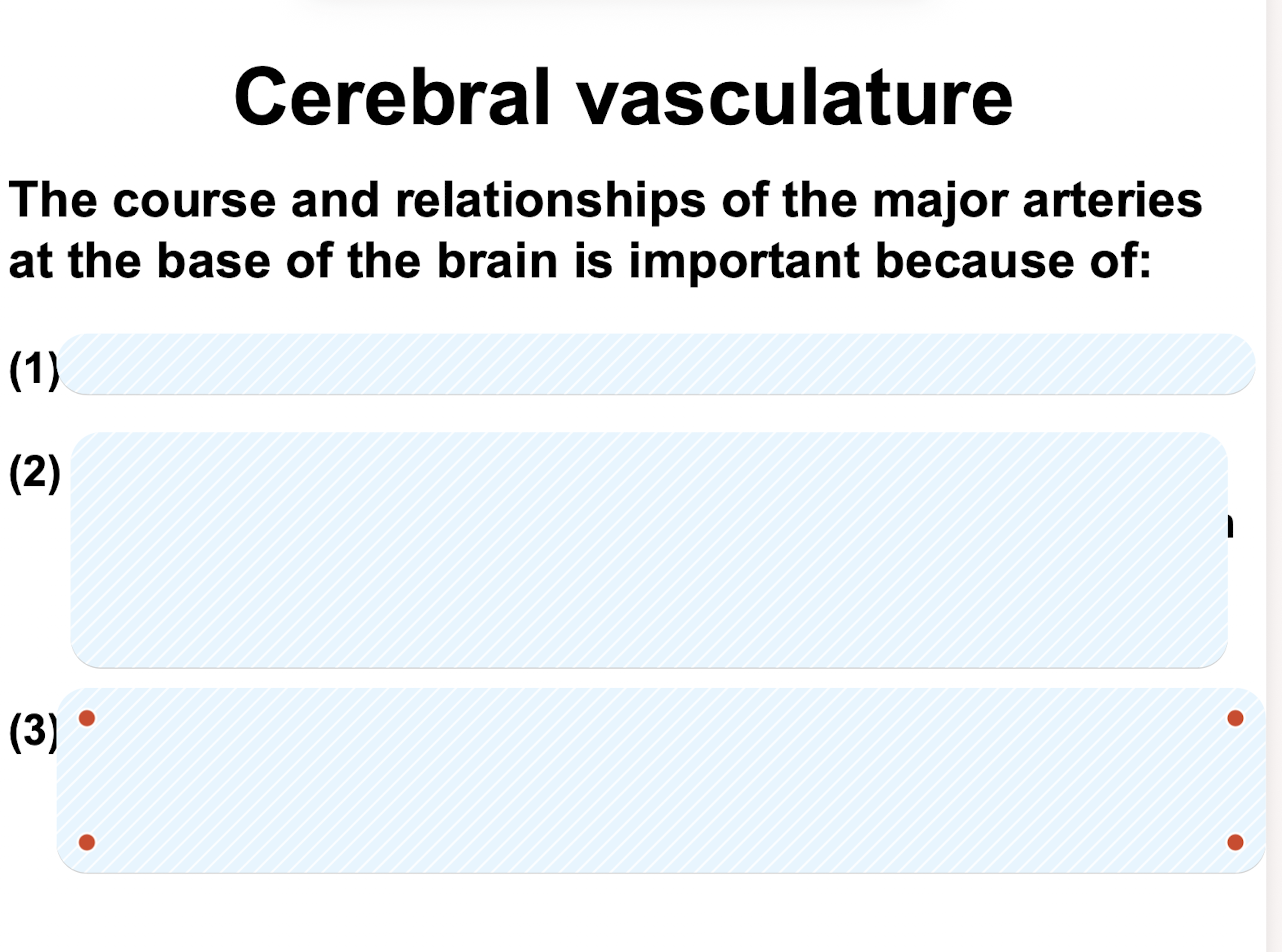
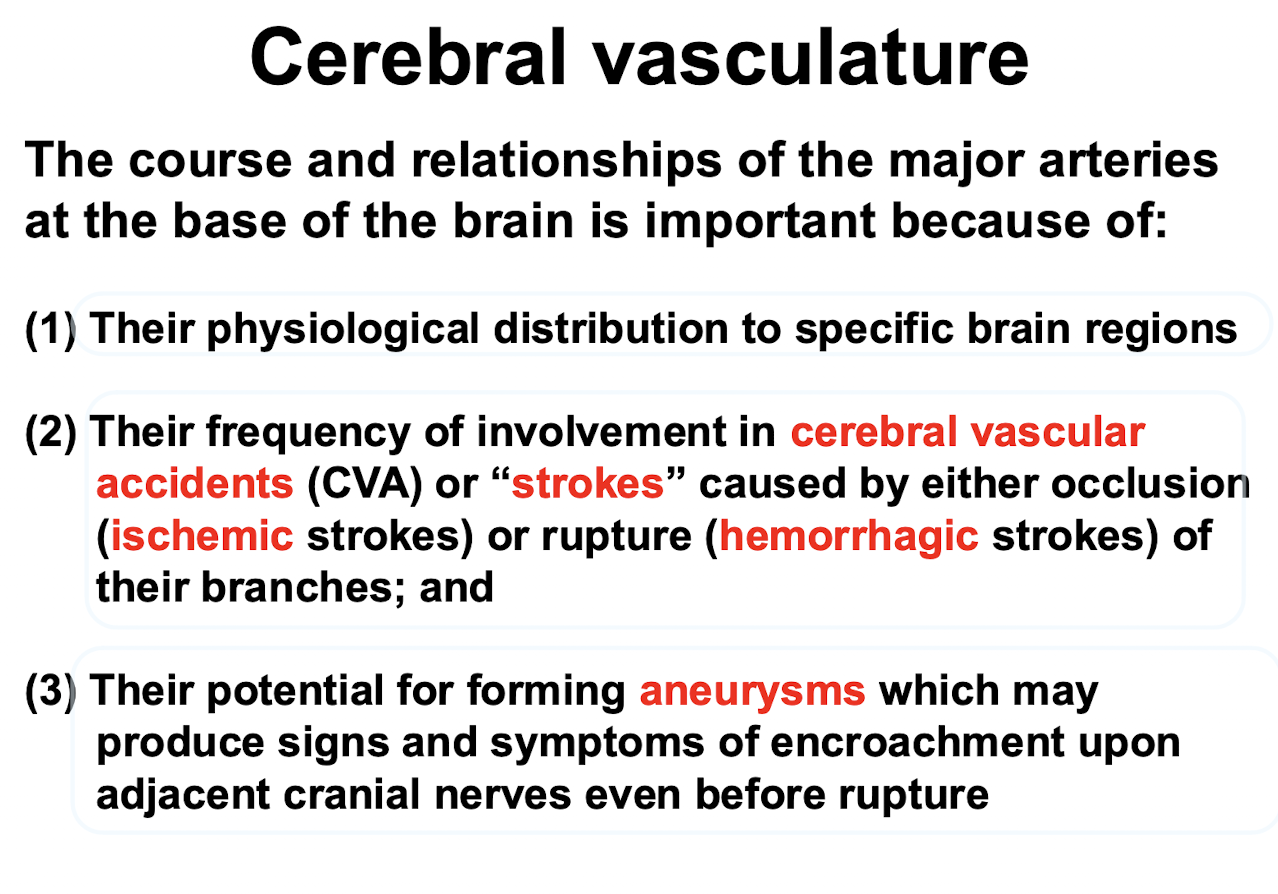
The ICA’s along with which major artery form the central arterial network?
The BASILAR ARTERY.
What is the primary responsibility of the vertebro-basilar arterial complex before it divides into the Posterior Cerebral Arteries (PCA)?
Blood supply of the brainstem and Cerebellum.
Where do arteries supplying the brain run?
In the SUBARACHNOID SPACE.
What may result from head trauma or rupture of an aneurysm or an AVM near the CIRCLE OF WILLIS?
SUBARACHNOID HEMORRHAGE.
A patient reports a sudden onset of “the worst headache of my life”; what serious vascular event is suggested?
Rupture of a saccular (berry) aneurysm near the CIRCLE OF WILLIS (Subarachnoid Hemorrhage).
What is the clinical consequence when cerebral vessels above the Circle of Willis (which are end arteries) suffer ischemic stroke?
Death (necrosis) of brain tissue.
How many branches does the EXTERNAL CAROTID ARTERY have; and what areas do they supply?
Eight branches; that supply blood to the superficial neck and face as well as the contents of the viscerocranial cavities.
List the eight branches of the External Carotid Artery (ECA).
1- SUPERIOR THYROID; 2- ASCENDING PHARYNGEAL; 3- LINGUAL; 4- FACIAL; 5- OCCIPITAL; 6- POSTERIOR AURICULAR; 7- SUPERFICIAL TEMPORAL; 8- MAXILLARY.
What vein is formed by a variable junction of the posterior auricular vein and the posterior division of the retromandibular vein at the angle of the mandible?
The EXTERNAL JUGULAR VEIN (EJV).
What vein does the EXTERNAL JUGULAR VEIN empty into at the base of the neck?
The subclavian vein.
Where does the INTERNAL JUGULAR VEIN (IJV) arise?
At the jugular foramen where the sigmoid and inferior petrosal sinuses empty into its dilated superior bulb.
The inferior end of the IJV features the ONLY venous valve between the brain and the right atrium; what type of valve is it; and what is its function?
It is a bicuspid valve; which prevents retrograde blood flow toward the brain when intrathoracic pressure increases acutely.
What cranial nerve courses through the carotid sheath along with the major vessels?
The VAGUS NERVE (CN X).
Clinically; how is the extent of venous congestion (e.g.; from increased right atrial pressure) indicated based on the IJV?
By the level of pulsations in the IJV; the higher the level of jugular pulsation; the greater the backup of blood.
What are the THREE main branches of CN X that distribute motor fibers to muscles of the pharynx and larynx?
RECURRENT (INFERIOR); PHARYNGEAL (joins CN IX); SUPERIOR LARYNGEAL.
Where do the DEEP CERVICAL LYMPH NODES draining the head and neck lie?
Along the internal jugular vein.
Why are the INFERIOR deep cervical nodes sometimes called supraclavicular or scalene nodes?
Because of their position above the clavicle and upon the surface of the scalene muscles.
What important clinical function do the inferior deep cervical (scalene) nodes serve regarding cancer spread?
They may serve as a final filter of tumor cells spreading through the lymphatic system from near or distant sites.
What are the boundaries of the POSTERIOR CERVICAL TRIANGLE?
Posterior border of SCM; Anterior border of TRAPEZIUS; and CLAVICLE.
What forms the roof of the Posterior Cervical Triangle?
The INVESTING LAYER of the cervical fascia.
What subdivides the posterior triangle further into the Occipital and Subclavian Triangles?
The INFERIOR BELLY of the OMOHYOID.
Where is the first pulse point for evaluating the blood supply to the upper limb located?
In the SUBCLAVIAN TRIANGLE (also known as the SUPRACLAVICULAR triangle).
What muscles form the FLOOR of the OCCIPITAL TRIANGLE?
SPLENIUS CAPITIS; LEVATOR SCAPULAE; and SCALENES (Posterior; Middle; Anterior).
What group of muscles do the scalenes belong to; and where do they attach?
PREVERTEBRAL MUSCLES; they attach primarily to anterior aspects of cervical vertebrae; including vertebral bodies and transverse processes.
What covers the prevertebral muscles anteriorly?
The PREVERTEBRAL FASCIA.
What is the action of the anterior group of prevertebral muscles (LONGUS CAPITIS; etc.)
The anterior group helps to initiate flexion of the head and cervical spine against resistance.
When the head and cervical spine are fixed; what accessory function do the SCALENES serve?
They serve as accessory muscles of respiration by elevating the rib cage.
Which rib does the ANTERIOR SCALENE attach to?
Rib 1.
Which major nerve descends through the neck on the anterior scalene muscles to reach the superior thoracic aperture?
The PHRENIC nerve.
Name the four sets of CUTANEOUS NERVES that arise from the cervical plexus.
TRANSVERSE CERVICAL; GREAT AURICULAR; LESSER OCCIPITAL; SUPRACLAVICULAR.
Referred diaphragmatic pain is perceived in what region; corresponding to which dermatome?
In the “shoulder pad” region; in the C4 dermatome.
What is ERB’S POINT (aka PUNCTA NERVOSUM) known for clinically?
These cutaneous nerves (from the cervical plexus) may all be anesthetized by an injection at this location.
A patient develops Ipsilateral shoulder drop following a minor surgical procedure near the neck; what nerve was likely injured at Erb’s point?
The SPINAL ACCESSORY NERVE (CN XI); because it crosses the posterior triangle to reach the trapezius.
What are the three divisions of the TRIGEMINAL NERVE (CN V)?
V1 - OPHTHALMIC DIVISION; V2 - MAXILLARY DIVISION; V3 - MANDIBULAR DIVISION.
Which foramina transmit the cutaneous branches of V1; V2; and V3 respectively?
SUPRAORBITAL (V1); INFRAORBITAL (V2); MENTAL (V3).
Describe the symptoms of Trigeminal Neuralgia (Tic doloureux).
Lancinating; paroxysmal pain; intermittent; unilateral; disabling.
What frequently triggers the pain in Trigeminal Neuralgia?
Moving the mandible; smiling or yawning; or by cutaneous or mucosal stimulation.
What is the suspected etiology of Trigeminal Neuralgia?
Demyelination or compression of the sensory root endocranially (often by the superior cerebellar artery).
What are the treatment options for Trigeminal Neuralgia?
Analgesics; anticonvulsants; surgical decompression; rhizotomy; gamma knife ablation.
Which two muscles are responsible for raising the upper eyelid; and how do they differ in innervation and muscle type?
LEVATOR PALPEBRAE SUPERIORIS (skeletal muscle; innervated by CN III OCULOMOTOR); and the SUPERIOR TARSAL MUSCLE (SMOOTH muscle; innervated by sympathetics).
A patient presents with PTOSIS; what two distinct neurological lesions could be the cause?
A lesion of either the sympathetic innervation (“Horner’s” Ptosis) OR CN III (“CN III Ptosis”).
Where do the preganglionic sympathetic fibers for the head and orbit arise; and where do they synapse?
They arise from the T1-T2 CORD SEGMENTS; and synapse in the SUPERIOR CERVICAL GANGLION.
How are almost all postganglionic sympathetics supplying the head distributed?
Through PERIARTERIAL PLEXUSES that surround the INTERNAL and EXTERNAL CAROTID ARTERIES and their branches.
Within the orbit; how do postganglionic sympathetics travel to reach the Superior Tarsal Muscle and the Pupillary Dilator?
They travel on CILIARY NERVES (LONG and SHORT).
List the clinical triad of Horner’s Syndrome.
PTOSIS (droopy eyelid); MIOSIS (fixed; constricted pupil); ANHIDROSIS (absence of sweating).
List the SIX MUSCLES OF OCULAR MOTILITY.
4 RECTUS muscles (SUPERIOR; INFERIOR; MEDIAL; LATERAL); and 2 OBLIQUE muscles (SUPERIOR; INFERIOR).
Where do the RECTUS MUSCLES arise from?
A COMMON TENDINOUS RING (ANNULAR TENDON) near the orbital apex.
What structures does the annular tendon encircle near the orbital apex?
The OPTIC FORAMEN as well as the medial end of the SUPERIOR ORBITAL FISSURE.
Describe the pathway of the SUPERIOR OBLIQUE muscle's tendon.
It runs forward and forms a round tendon which passes through a cartilaginous loop; the TROCHLEA; and is redirected to its insertion on the sclera.
With the exception of two muscles; all extraocular muscles are innervated by CN III; which two muscles are the exceptions?
SUPERIOR OBLIQUE (CN IV) and LATERAL RECTUS (CN VI).
What type of fibers does CN III carry that are preganglionic parasympathetic; and where do they synapse?
GVE fibers; synapsing in the CILIARY GANGLION.
Which cranial nerve has the longest intracranial course?
CN IV TROCHLEAR NERVE.
Which cranial nerve has the longest extradural course in the cranial cavity; making it frequently involved in intracranial disease?
CN VI ABDUCENT NERVE.
Around what axis do ELEVATION and DEPRESSION of the eyeball occur?
Around a MEDIOLATERAL AXIS through the center of the eyeball.
Around what axis do ABDUCTION and ADDUCTION of the eyeball occur?
Around a VERTICAL AXIS through the center of the eyeball.
What terms describe rotation of the eyeball around the visual axis (anteroposterior axis)?
INTERNAL ROTATION (INTORSION) and EXTERNAL ROTATION (EXTORSION).
Which two extraocular muscles move the eyeball around a single axis only (Abduction or Adduction)?
MEDIAL RECTUS and LATERAL RECTUS.
List the primary actions of the SUPERIOR OBLIQUE.
DEPRESSES; ABDUCTS; INTORTS.
List the primary actions of the INFERIOR OBLIQUE.
ELEVATES; ABDUCTS; EXTORTS.
List the primary actions of the SUPERIOR RECTUS.
ELEVATES; ADDUCTS; INTORTS.
List the primary actions of the INFERIOR RECTUS.
DEPRESSES; ADDUCTS; EXTORTS.
Which neurovascular structures enter the orbit through the SUPERIOR ORBITAL FISSURE?
CN III; CN IV; CN VI; and V1 (Ophthalmic Artery is also mentioned near this area; but CNs III; IV; VI; and V1 are listed as entering through the fissure).
Which of the nerves passing through the cavernous sinus is listed as the CLOSEST NERVE TO THE INTERNAL CAROTID?
CN IV.
A patient suffers a Right CN III (GSE) lesion. Describe the resultant position of the eyeball.
The eyeball will be “down and out” (abducted and slightly depressed); because LR(6) and SO(4) are unopposed.
A patient presents with paralysis of the Left Lateral Rectus muscle. What two clinical findings will be observed in the left eye?
Medial strabismus (adduction due to unopposed medial rectus pull); and HORIZONTAL DIPLOPIA.
What compensatory movement might a patient with a RIGHT CN IV palsy (Superior Oblique loss) use to reduce vertical diplopia?
The patient may tilt the head CONTRALATERAL to the side of the lesioned CN IV.
How do you clinically test the Superior Oblique muscle (CN IV)?
Ask the patient to look down and in (adduct and depress).
What is the proper clinical instruction to test the Lateral Rectus muscle (CN VI)?
Ask the patient to ABDUCT.
What two structures do postganglionic parasympathetics innervate after synapsing in the CILIARY GANGLION?
The PUPILLARY CONSTRICTOR and CILIARY MUSCLE.
By what general mechanism do postganglionic axons arising from the parasympathetic ganglia of the head reach their targets?
By “piggy-backing” on branches of CN V (Trigeminal Nerve).
What type of fibers does CN V1 (Ophthalmic division of the trigeminal nerve) exclusively carry into the orbit?
GSA fibers (General Somatic Afferent).
Where do the preganglionic parasympathetic fibers that control pupillary constriction originate?
MIDBRAIN - Nucleus of Edinger-Westphal.
What is ANISOCORIA; and what does it suggest?
Inequality in the size of the pupils under changing light conditions; suggests a lesion in a pupillary autonomic pathway.
What two actions are required for near vision (ACCOMMODATION)?
Contraction of the CILIARY MUSCLE (to increase lens curvature) and PUPILLARY CONSTRICTOR action.
If the parasympathetic pathway (GVE) carried by CN III is lesioned; describe the pupil's state and accommodation ability.
The pupil will be FIXED and DILATED (mydriasis) because the constrictor is paralyzed; and there will be no accommodation of the lens because the ciliary muscle is paralyzed.